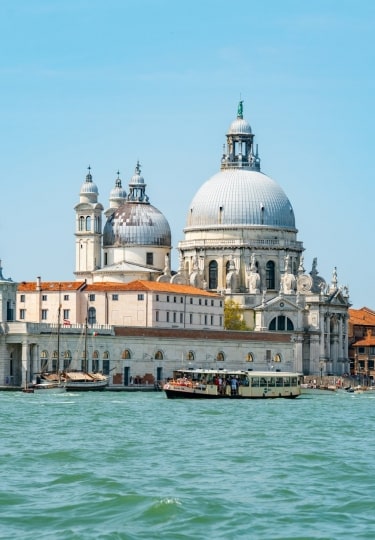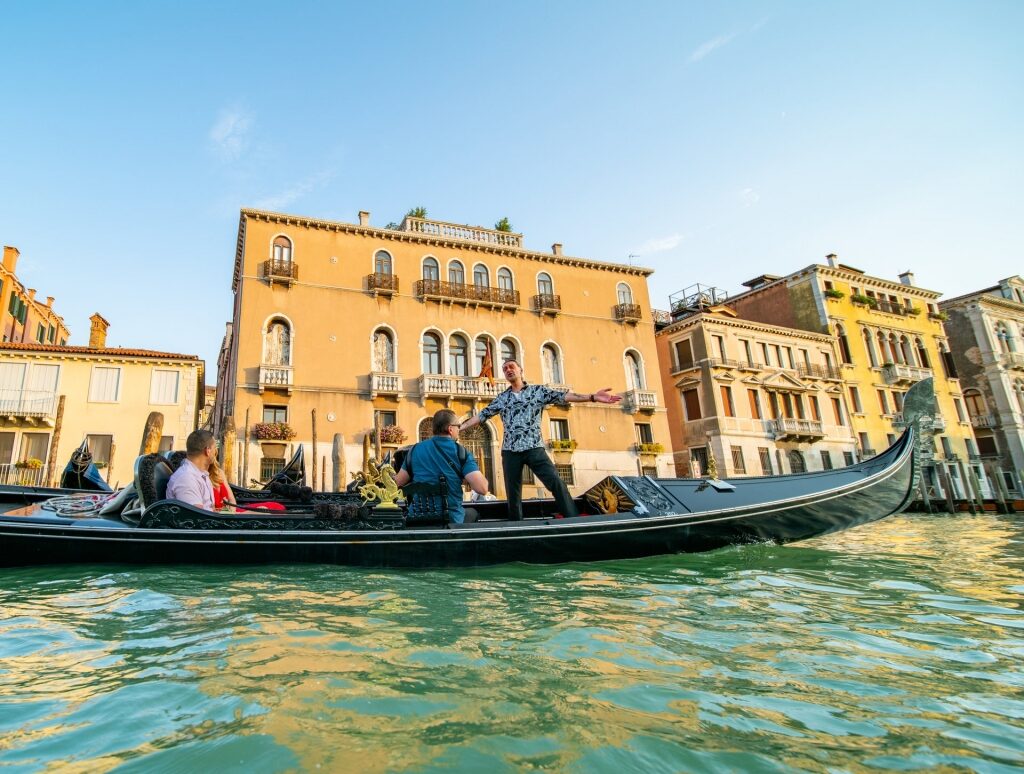Whittling down a list of the most beautiful cities in Italy has something of the Judgement of Paris about it—it’s an almost impossible challenge.
The truth is you could visit almost anywhere in the Italian peninsula and encounter the glamor, style, history, culture, and flair that makes this sunny strip of Europe such an attractive destination.
This article includes the prettiest cities in Italy as well as those that offer a beauty perhaps not as immediately apparent as the Gothic enchantments of Venice or the muscular charm of Rome. Beauty is subjective, often reliant on things like the right light, the right wine, and the right company (thankfully, Italy has these three factors in envy-inducing abundance).
Rome
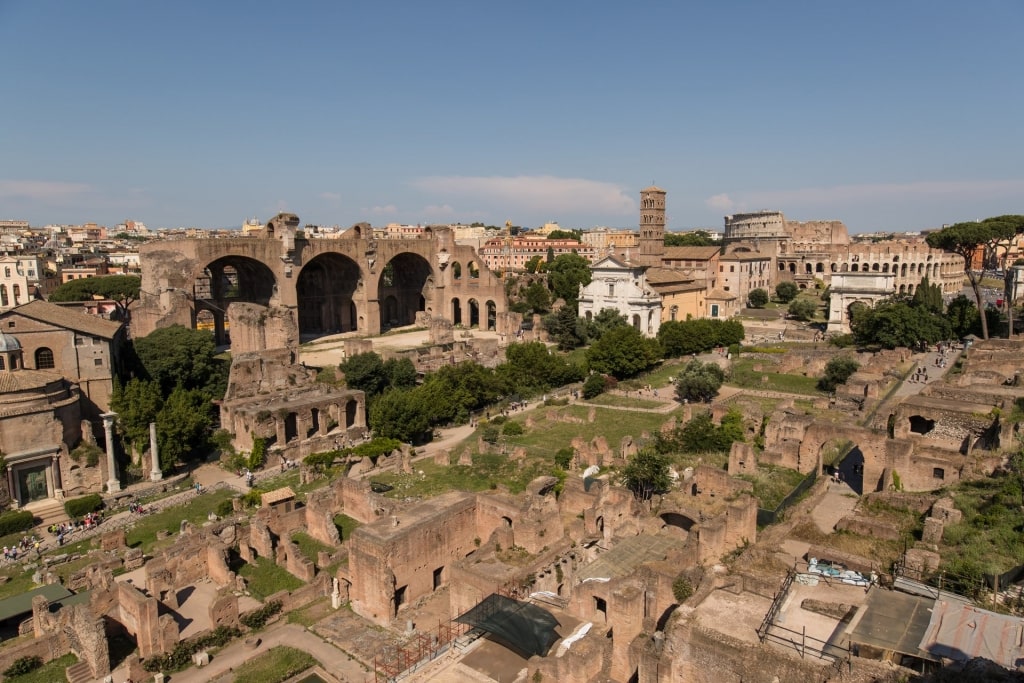
Roman Forum, Rome
It might occur to prospective travelers that such an attractive headline destination as Rome—the capital of “il bel paese”—might have had the very beauty knocked out of it by so many centuries of self-inflicted eminence.
Fortunately, as visitors awakening in Rome have confirmed when the soft light of dawn illuminates its many treasures, the capital remains one of the most beautiful cities in Italy.
Its immortal elegance arrayed across its seven famous hills, Rome supplies layers upon layers of intrigue and astonishment carefully acquired since its founding in the 8th century BC. The city houses famous landmarks in Europe like the Roman Forum, the Pantheon, the Column of Marcus Aurelius—the list seems endless.
But it’s not all a matter of antique beauty—simply walking the cobbled streets, crossing the travertine-clad bridges, and admiring the lingering sunsets quickly educates as to why Paolo Sorrentino chose to call his Oscar-winning film about Rome, The Great Beauty.
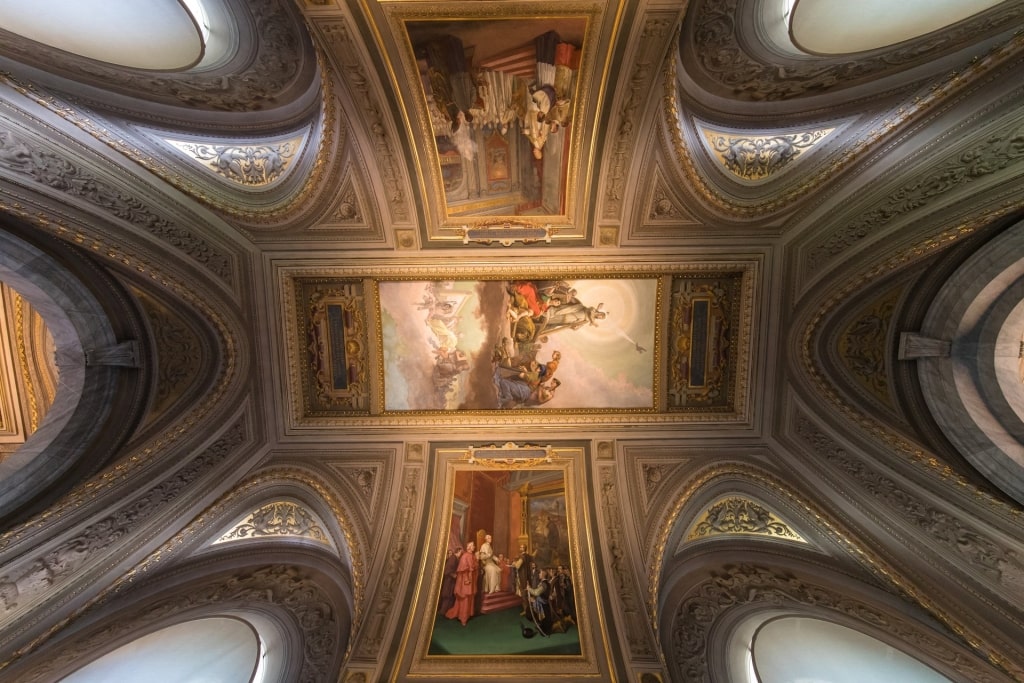
Sistine Chapel, Rome
Spend at least three days in Rome and let the city seduce you inside and out, whether you’re gazing at Michaelangelo’s masterpiece within the Sistine Chapel or the triumphant tiers of columns on the Colosseum’s exterior. One of the most beautiful cities in Italy? Of course—and also the most charismatic.
Read: Explore Rome Off-the-Beaten Path
Perugia
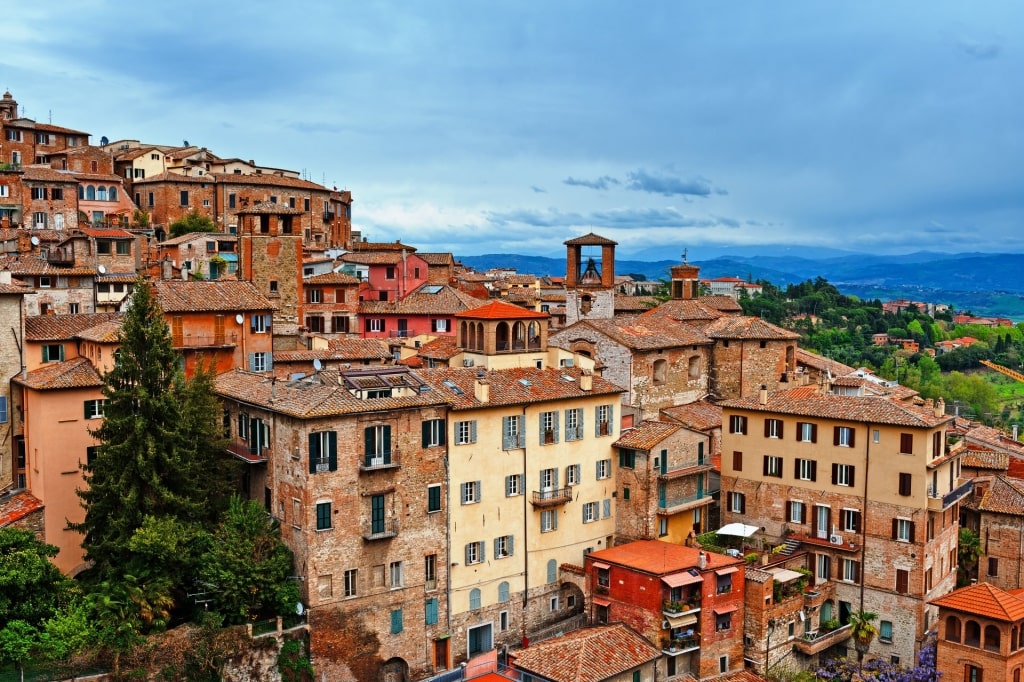
Perugia
Umbria is a landlocked province in central Italy that’s often referred to as the country’s “green heart”. Bisected by the Tiber on its journey to Rome, it’s a favorite with Romans (it’s a two-hour drive from the capital) who see its pristine wilderness and remarkable destinations such as Assisi, Norcia, and Castelluccio as offering a quieter, more rustic alternative to Tuscany.
Equally popular is Perugia, the regional capital and easily one of the most beautiful cities in Italy. A well-preserved medieval city with a bustling student body supplied by its two universities, compact Perugia is made up of only five neighborhoods (or borgos) holding a population roughly a tenth the size of San Diego.
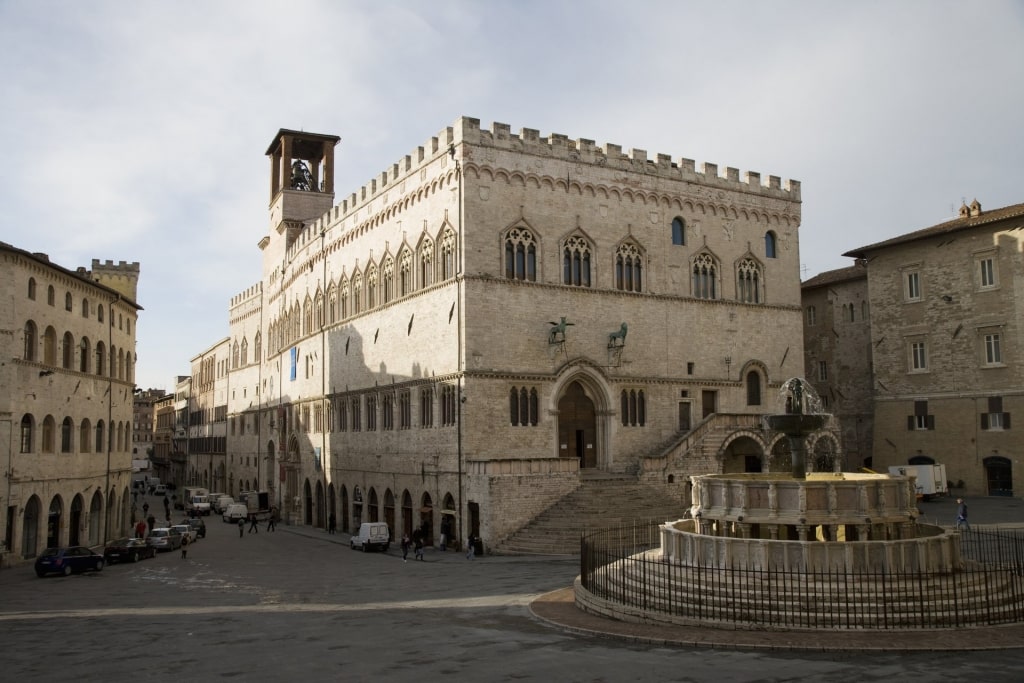
Corso Vannucci, Perugia
If you’re only in the city for a short visit, be sure to find a seat on one of the streetside cafes on Corso Vannucci, order an espresso macchiato, and enjoy one of the country’s best people-watching streets.
The Vannucci that gave his name to Perugia’s main drag was a Renaissance artist also known as Perugino. Famous in his own right, Perugino was also Raphael’s teacher, and you can compare the master’s work against the student’s at the impressive Galleria Nazionale Dell’Umbria.
With the rest of your time, settle into the joyous rhythms of Borgo Bello—arguably the city’s most attractive neighborhood—dropping into bars, restaurants, and public gardens with the rolling green hills of Umbria rising up around you.
Florence
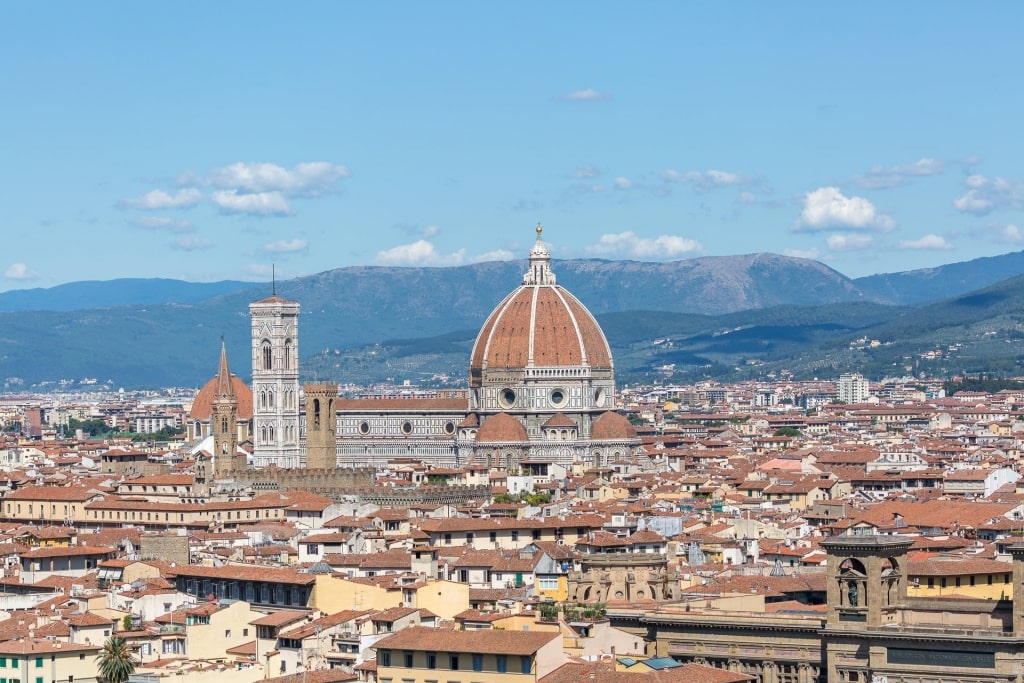
Florence
Florence, the crucible of the Renaissance found about an hour’s drive from Pisa’s Leaning Tower, hardly needs an introduction. The city is an automatic choice for a feature about Italy’s most beautiful cities.
Florence is known for its artistic, architectural, and cultural treasures. The historic center can feel more like a museum than a place where people can actually live.
In one of the best cities for art in the world, you’ll be transported by the soft sun gleaming off of the Duomo’s pale marble exterior, swoon at Michaelangelo’s immaculate David, and be entranced by Raphael’s Maddalena Doni in the Palatine Gallery.
But what makes Florence more than the sum of its Renaissance parts? The Renaissance came and went but Florence remained, and so did its sense of fashion.
A huge part of the city’s cultural weft, contemporary fashion in Florence is intrinsically tied to the names of Gucci and Ferragamo. Find their museums to see how the stylistic genius of these icons progressed from Tuscan sensations to worldwide stardom.
Read: Two Days in Florence
Genoa
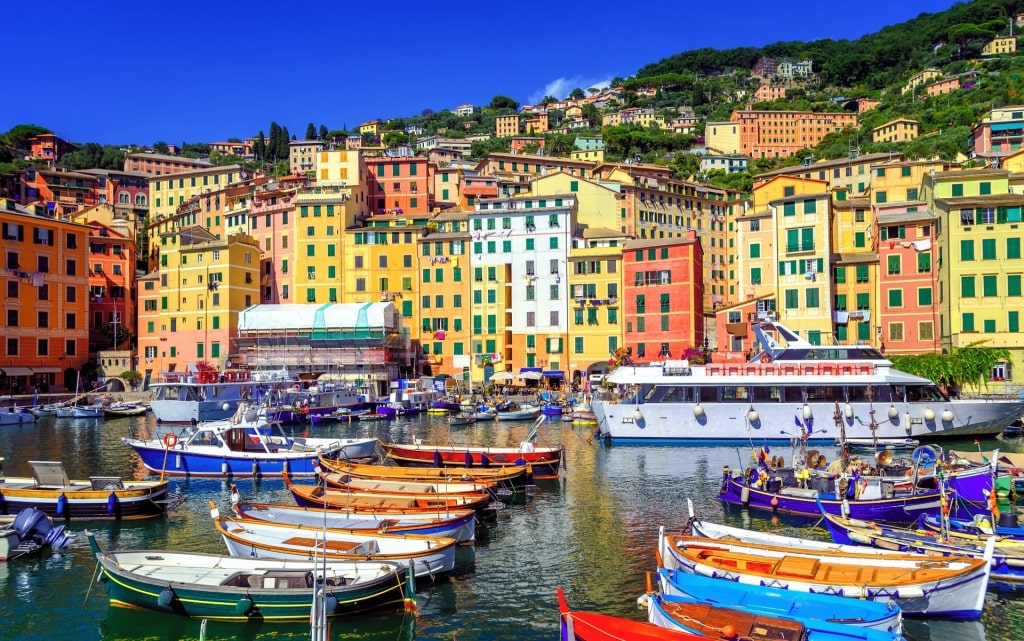
Genoa
If you asked an Italian, they’d probably balk at the idea of this grand port city in an article about the most beautiful cities in Italy. While Genoa is the capital of the Italian Riviera, known for picture-perfect destinations such as Portofino, San Remo, and Cinque Terre, Genoa is of a distinctly less dainty disposition than these world-renowned spots.
However, Genoa makes this list for its remarkable interior beauty. With its great wealth accumulated during the medieval period, the former Republic of Genoa splurged on its Rolli Palaces. These 150 UNESCO-listed Renaissance gems, once the property of Genoa’s all-powerful merchant class, are now employed as anything from schools to banks and even public housing (some of the finest examples, however, are maintained as museums).
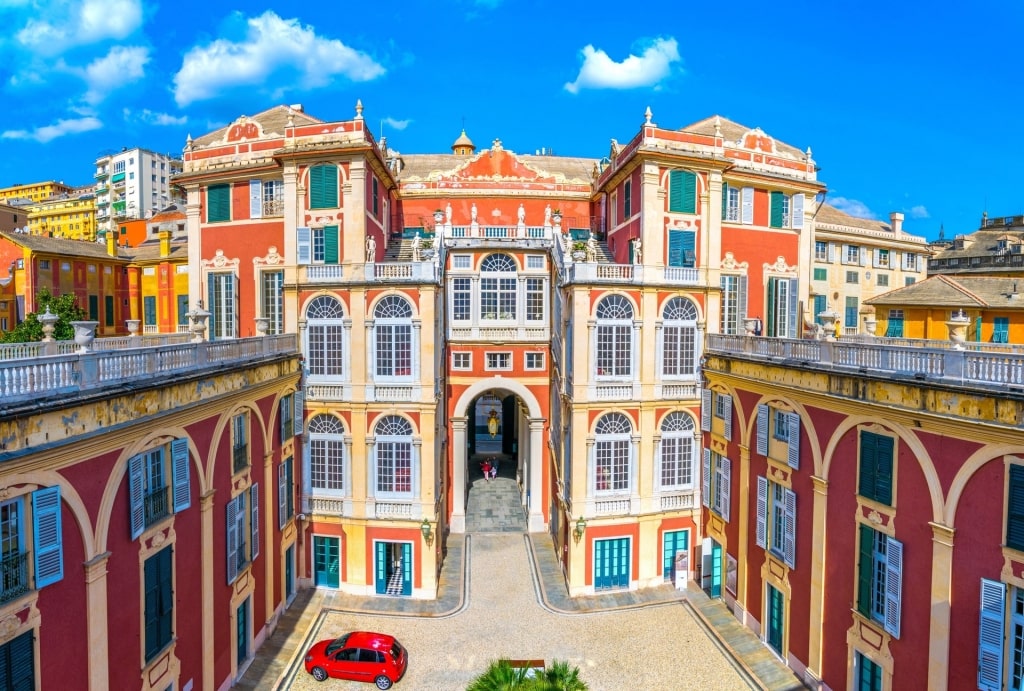
Palazzo Reale, Genoa
Annually, over three weekends, the palaces are open to the public, allowing a grand tour of the city’s eye-popping frescos and ornate gilt interiors. It’s a glittering underbelly belied by the otherwise ordinary Italian handsomeness of Genoa.
Of course, this city is also famed for having the largest intact medieval center in Europe (also the same postcode as 42 of the most luxurious Rolli). Whether you find the Centro Storico’s atmospheric flag-stoned alleys and piecemeal piazzas beautiful, however, is something to muse over during a focaccia-heavy Genoese aperitivo.
Read: Classic Cities and Towns in the Italian Riviera
Siena
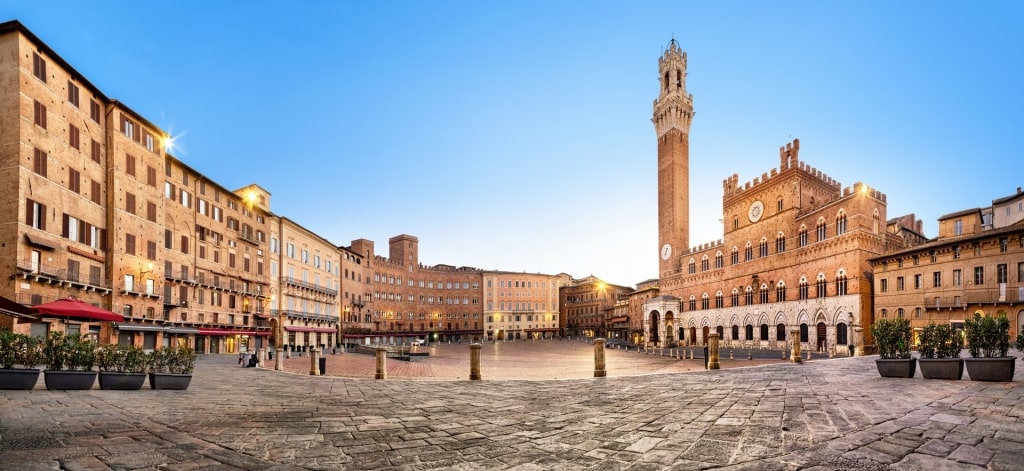
Siena
Siena finds it impossible to avoid comparisons with its larger Tuscan sibling of Florence, so intertwined are the two histories of these former rival republics. That Siena stands up to the comparisons is testimony to its otherworldly charm—the quieter, more intense brother to Florence’s extrovert dandy.
Siena’s tightly wound Gothic streets ramble attractively over a hill in the region’s heartland, about two hours’ drive from Pisa. Children chase down the maze of narrow lanes while cafe seating hopscotches up the steep streets searching for level(ish) perches. As you wander, views over back gardens let in the light, the fragrant herb gardens verdant with the reliable Tuscan sun.
The city suddenly opens up when you enter the reeling Piazza del Campo, home to Siena’s world-famous, fiercely competitive Palio horse race for which the herringbone brick surface is softened with a track of sand. The Gothic architecture reaches its zenith at Siena’s striped 13th-century cathedral, which conceals within its artful gloom the shining Renaissance pearl of the Piccolomini Library.
Venice
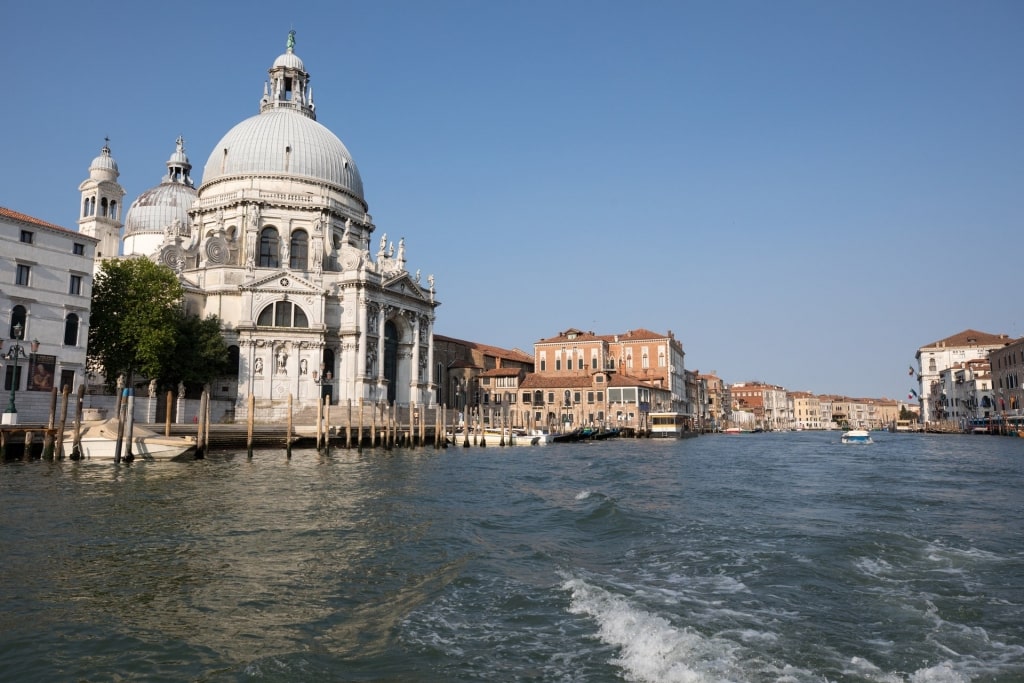
Venice
La Serenissima (or “Most Serene”) has been one of Venice’s official titles since its heyday as an ambitious and powerful medieval republic. Today, this floating city is more likely to be called the most romantic place in Italy.
Venice is easily one of the prettiest cities in Italy. The Venetian Gothic architecture applies a delicate lace of stonework to its narrow windows and intimate overwater balconies. The city’s many miles of canal slink along dusky pink and yellow channels, while the illustrious domes of St. Mark’s Basilica float above its namesake square like tethered balloons.
Spend a starlit evening in St. Mark’s sipping chilled Vermentino al fresco while you listen to your restaurant’s string quartet, and you might find yourself googling Italian citizenship.
But La Serenissima’s arsenal consists of more than just its obvious charms. A short vaporetto ride from St. Mark’s Square, the island of Giudecca is quietly transforming itself from an unpromising industrial neighborhood into one of the city’s hot spots for contemporary art. Modernity also has a place in this classical beauty.
Read: European Honeymoon Destinations
Turin
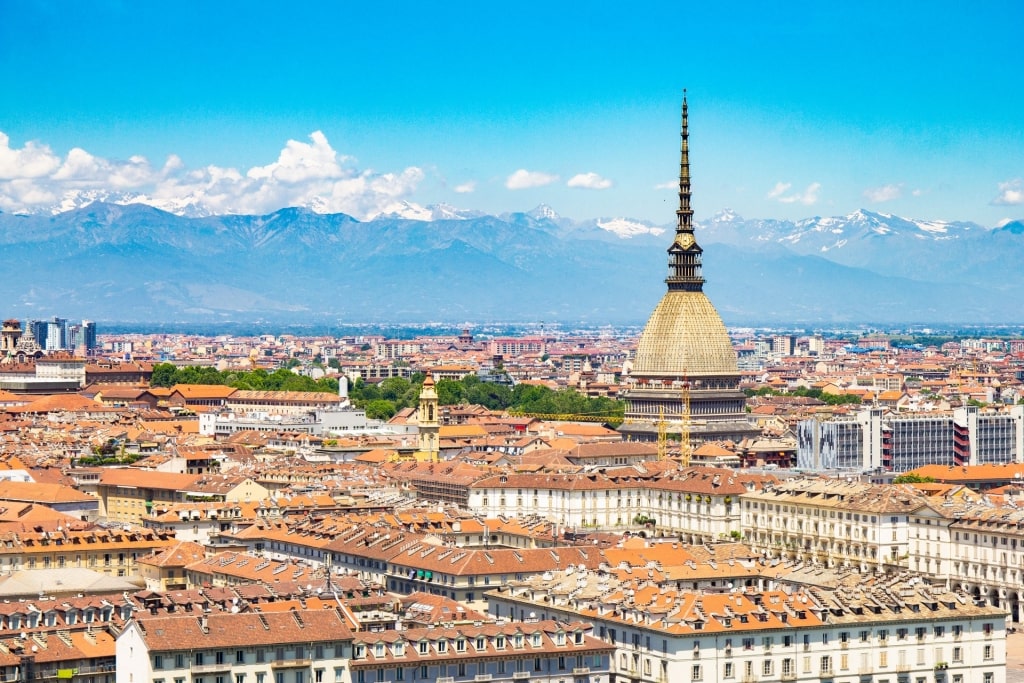
Turin
The seat of the Savoy royal family, Turin—just under three hours’ drive from Portofino—maintains a quiet dignity and a faded elegance. You’ll find it in the tree-lined boulevards, extravagant palazzos, and the towering backdrop of the snow-capped Alps marking the border with France (best viewed from the top of the city’s symbol, the Mole Antonelliana building).
Make your way swiftly through the city’s industrial extents—Turin is home to Fiat and Alfa Romeo—and into the colonnaded center with its stately avenues. Here you’ll find the spacious urban planning of kings, of ceremony and pomp, with the intention to daunt and dazzle.
Wander the former capital’s idiosyncratic piazzas or pound the marble pavements of boutique-lined Via Roma, recharging with a luxurious bicerin: a regional specialty hot chocolate made with a layer of coffee and another of cream.
The province of Piedmont is, even in Italy, lauded for its cuisine. For a regional trifecta of gastronomic bliss, marry Alba white truffle and rich tajarin egg pasta with a good 20-year-old Barolo. Inhaling violets while soft tannins caress your tongue, muse that perhaps Turin’s quiet dignity is just the sound of a populace with its mouths full.
Lucca
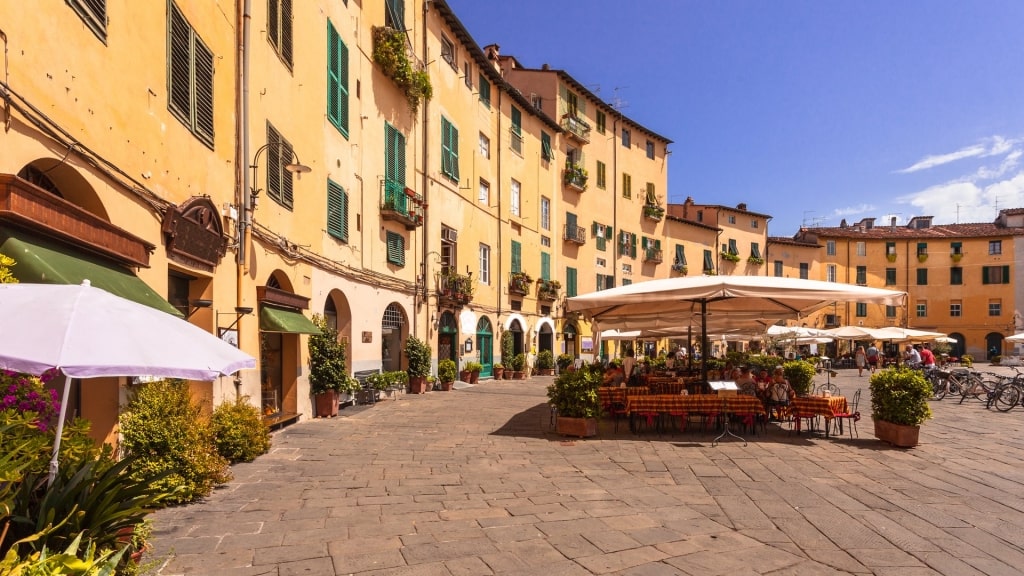
Lucca
Under half-an-hour’s drive from Pisa, visiting Lucca is one of the best things to do in Tuscany. This gem is ensconced in the hilly hinterland between Tuscany’s golden coast and the Renaissance kingpin of Florence.
Its historic center encircled by massive—and intact—medieval walls, Lucca was once one of the region’s richest cities. Within this secure stone embrace, the medieval Lucchesi wrought a town plan riddled with snaking alleys and pleasant piazzas shaded by orderly plane trees.
While visiting this Swiss watch of a city, a sense of wellbeing and exclusivity inevitably descends.
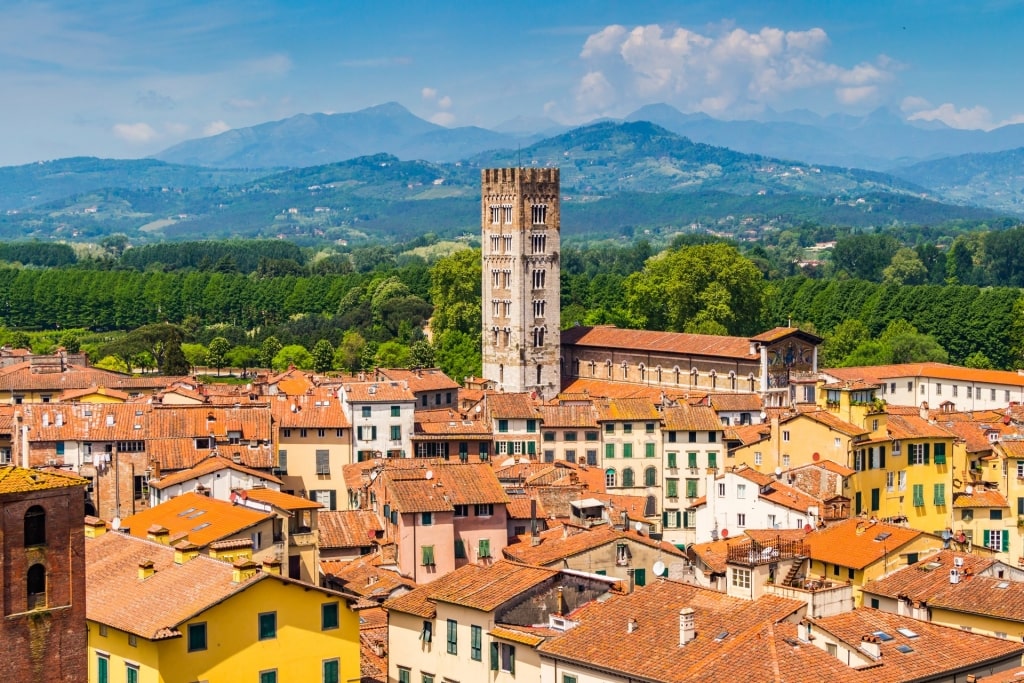
Lucca
Ambiance aside, Lucca’s tangible warren of historic buildings, high-end shops, and timeless cafes makes for a memorable day trip. And that’s only the area below the walls. So accommodatingly wide are the Renaissance-era fortifications that you can hire a bike and do a loop of the town from above. You’ll pass the locals relaxing in the shady parks found on the same elevated level, bulging like billiard-table pockets out of the wall’s line.
Be sure to keep a few euros aside to ascend to the top of the Guinigi Tower. The symbol of Lucca, instantly recognizable for the trees sprouting from its crown, the Guinigi’s balcony offers extraordinary views over Lucca’s intricate urban plan and great angles on the gorgeous Tuscan countryside that surrounds it.
Syracuse
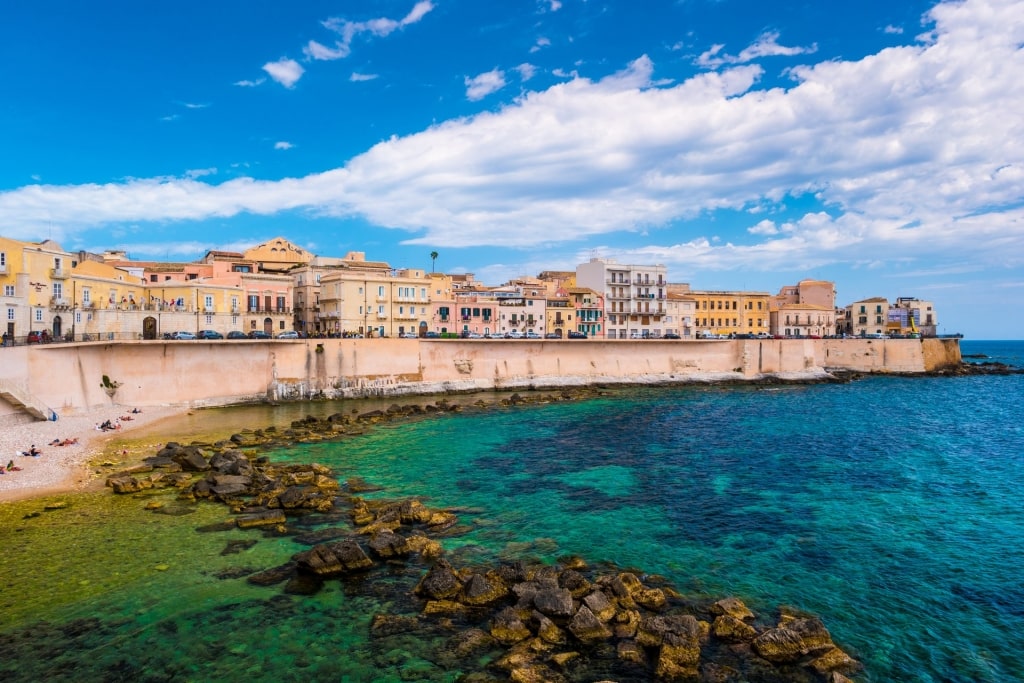
Syracuse
Founded in 734 BC by the Greeks, Syracuse, as seen when approaching across the turquoise Ionian Sea, is a baroque froth of shining limestone rising from the coffee-colored Sicilian earth. From afar, and close up, it’s simply one of the most beautiful cities in Italy and one of the best places to visit in Sicily.
An expert-led tour is the best way to satisfactorily navigate the immense visible history of the Sicilian city’s enchanting interior. Your tour will most likely emphasize how one empire built on the footprint of the last, exemplified by the 7th-century cathedral standing resplendent on the foundations of a Roman temple.
You’ll also see the centers of life in the town, from the sophisticated crescent of the Piazza del Duomo with its sprawling cafe terraces to the morning markets echoing with the shouts of vendors hawking fresh octopus, punnets of glossy red strawberries, and weighty pearls of creamy mozzarella.
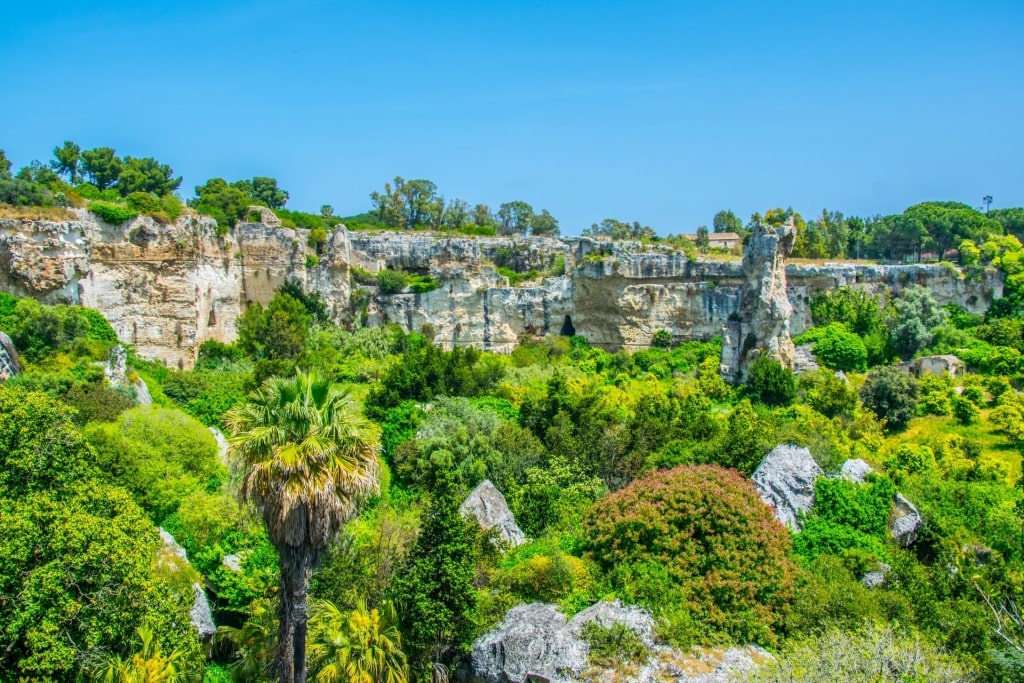
Latomia del Paradiso, Syracuse
Outside of the historic center of Ortigia, treasures such as Latomia del Paradiso await— an enchanting Italian garden set within what were once limestone quarries that helped build the ancient city. Wander amid the sweet scent of the citrus trees mingled with the musky richness of the creeping jasmine. Fathoming the full beauty of this Sicilian city is a multi-sensory journey.
Read: Magical Towns in Sicily to Explore
Brindisi
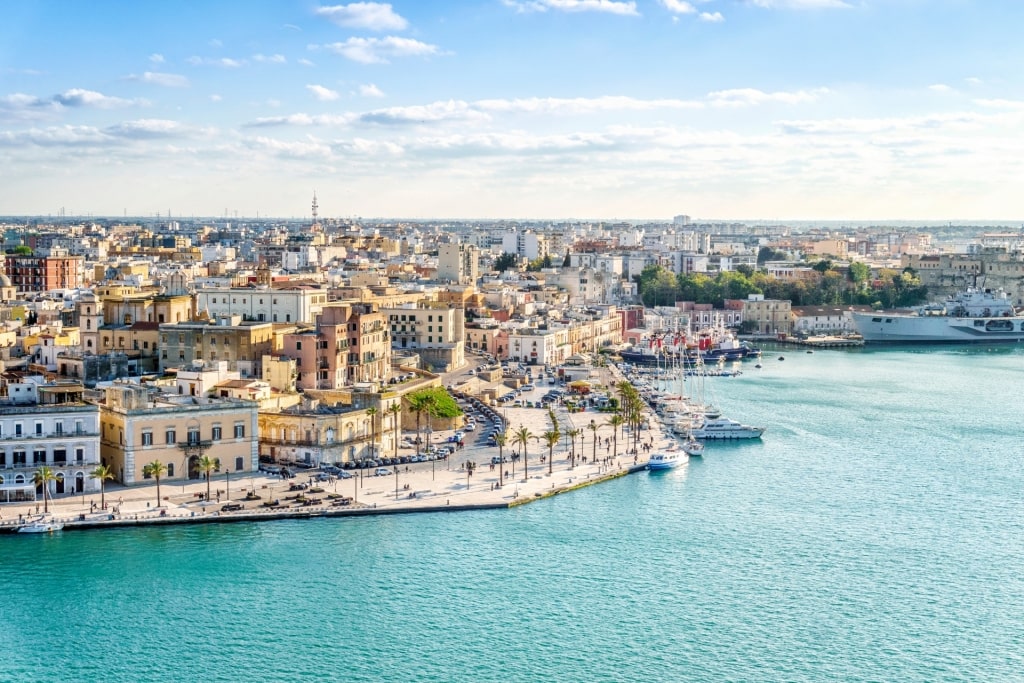
Brindisi
Brindisi, in Southern Italy, is one of the most beautiful cities in Italy. This ancient sun-bleached Puglian port rambles around a natural inlet filled with the aquamarine waters of the Adriatic Sea. The inlet is apparently shaped like a deer’s head, which gave the port its name in antiquity.
Located midway along the peninsula’s “heel”, Brindisi has long been of strategic importance and its history pre-dates the Romans. The port city’s importance to those empire-builders is exemplified by the famous Via Appia Antica. This cross-country Roman highway connected the port directly to Rome, which considered Brindisi the gateway to the east.
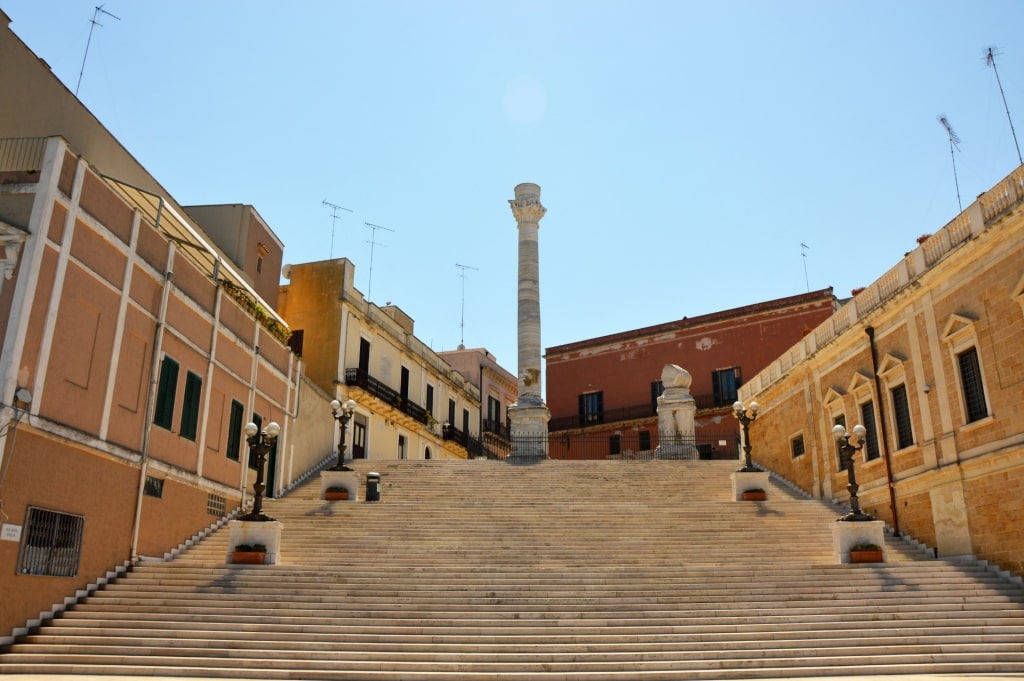
Via Appia Antica, Brindisi
At the top of the stately Virgil Staircase on Brindisi’s waterfront, a single Corinthian column stands to mark the end point of the Via Appia Antica. It’s a striking sight set in the city’s charming historic center, a neighborhood of bleached limestone and salmon-pink marble flagstones lightened over centuries by the strong Mediterranean sun.
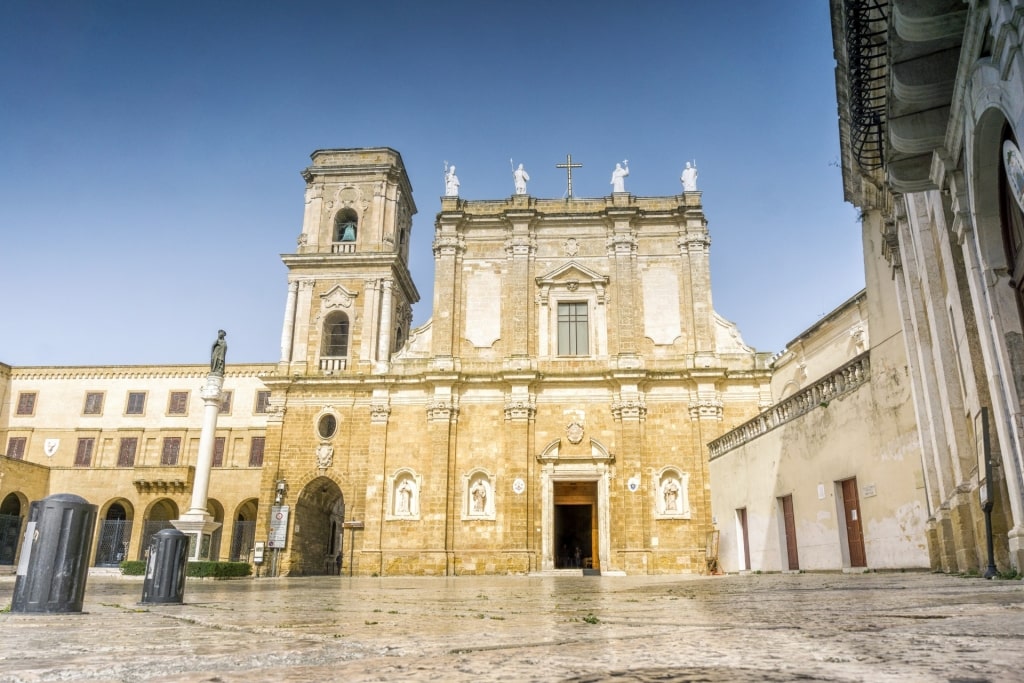
Piazza Duomo, Brindisi
You’ll also find Piazza Duomo here, with its assembly of well-preserved medieval and Roman-era buildings. With such an old city, there’s a wealth of archaeological treasures and fortifications to explore.
But you’ll always find yourself returning to the sea breezes found on the palm-lined Regina Margherita promenade, with its views towards the Aragonese castle that guards the harbor entrance. The promenade is also the heart of the city’s nightlife. Try Numero Primo Wine Bar for a delicious aperitivo hour as the sunset plays over the surface of the sea.
Cagliari
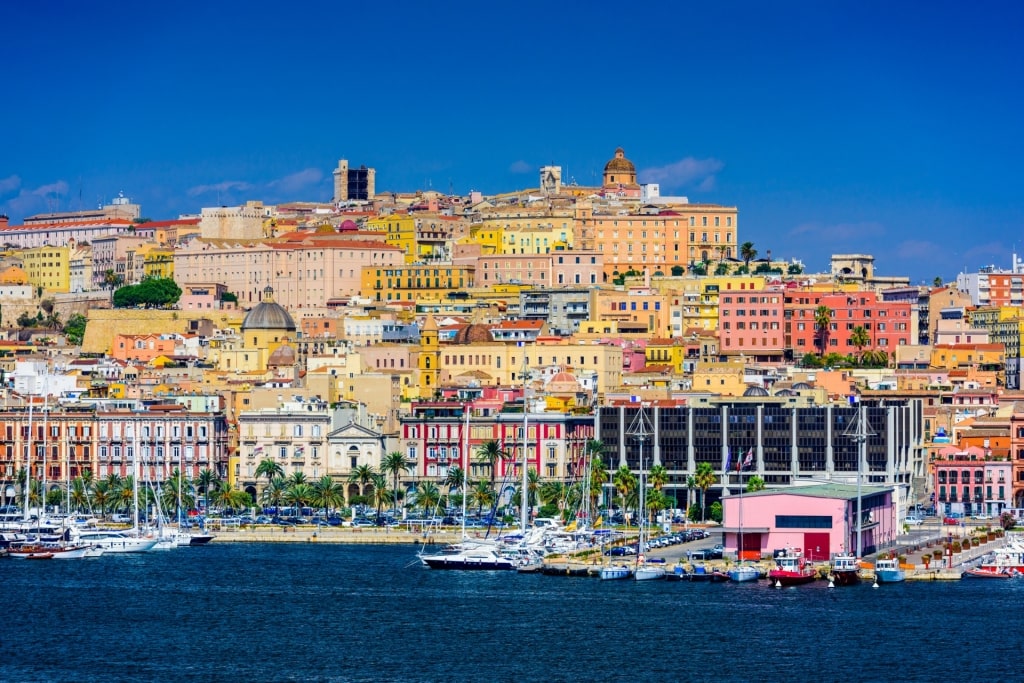
Cagliari
Sardinia’s capital, Cagliari, would be a remarkable place even if it wasn’t one of the most beautiful cities in Italy. Cagliari is installed in a niche on the western coast, its elevated position offering views over a bay, one of the island’s best beaches, and a flamingo-filled national park.
Its historic center of Il Castello, the name speaking to the island’s besieged history, is a mishmash of atmospheric alleyways leading to ancient buildings and legendary trattorias. You’d be a fool not to invade.
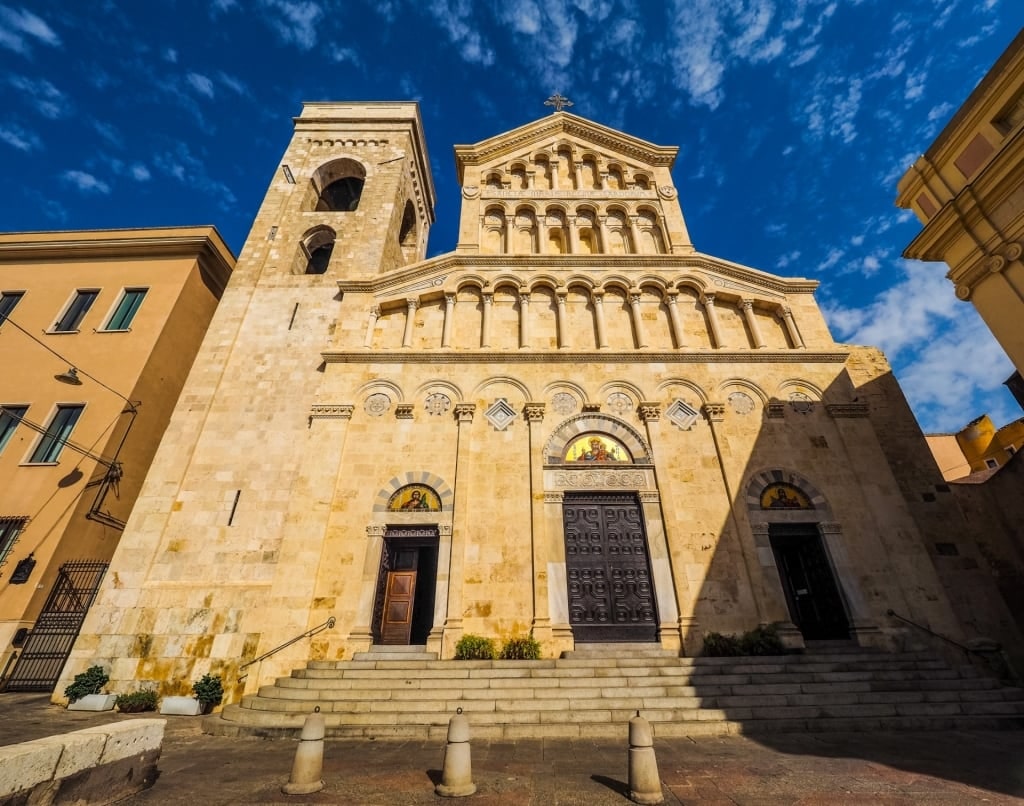
Cattedrale di Santa Maria, Cagliari
Standing tall among the aged watchtowers in Il Castello is the majestic Cattedrale di Santa Maria. The duomo’s bell toll rolls downhill, as it has for centuries, through the pastel-hued buildings that line the promenade, and into the turquoise surf of Poetto Beach, one of the best beaches in Italy.
As you tour the city’s busy markets, you’re taken on a sumptuous sensory adventure. The fusions of African and European flavors gather irresistibly in the air, as does the scent of the sea. You’ll browse food stalls, taste fresh ricotta, sip the local Vermentino wine, and sidle up to the honey-drizzled seadas pastries.
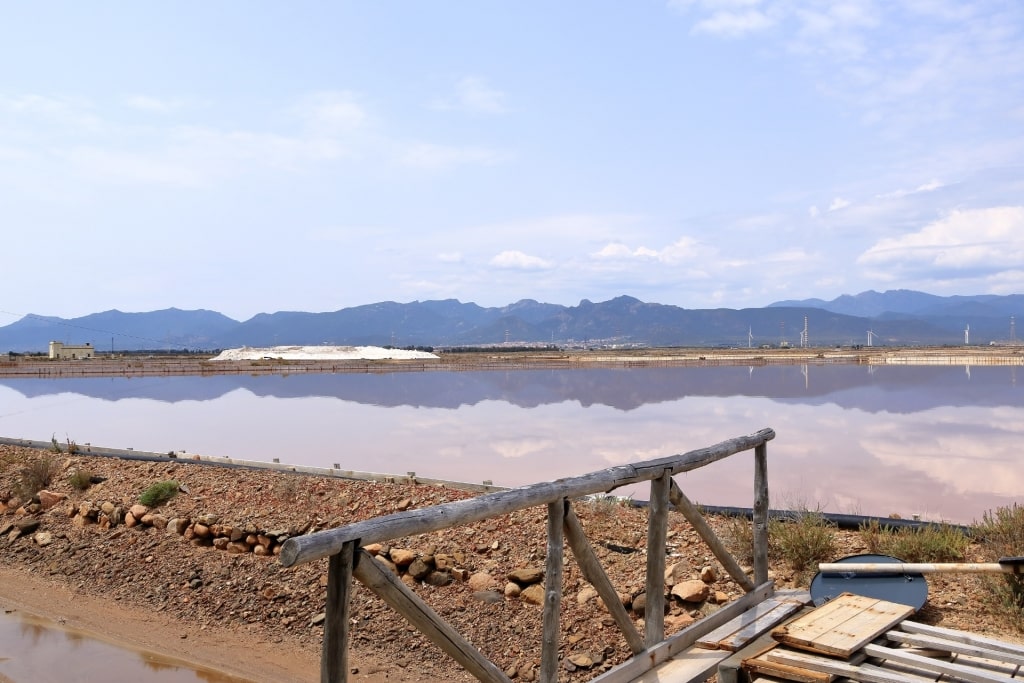
Parco Naturale Molentargius Saline, Cagliari
Walk it off on the boardwalks of the Parco Naturale Molentargius Saline, now a nature reserve, but once part of the island’s Phoenician-era salt industry. Visiting today, you could spot egrets, glimpse a Sardinian deer, and see the sunset’s pink hues reflected in the resident flamingos’ feathers.
Catania
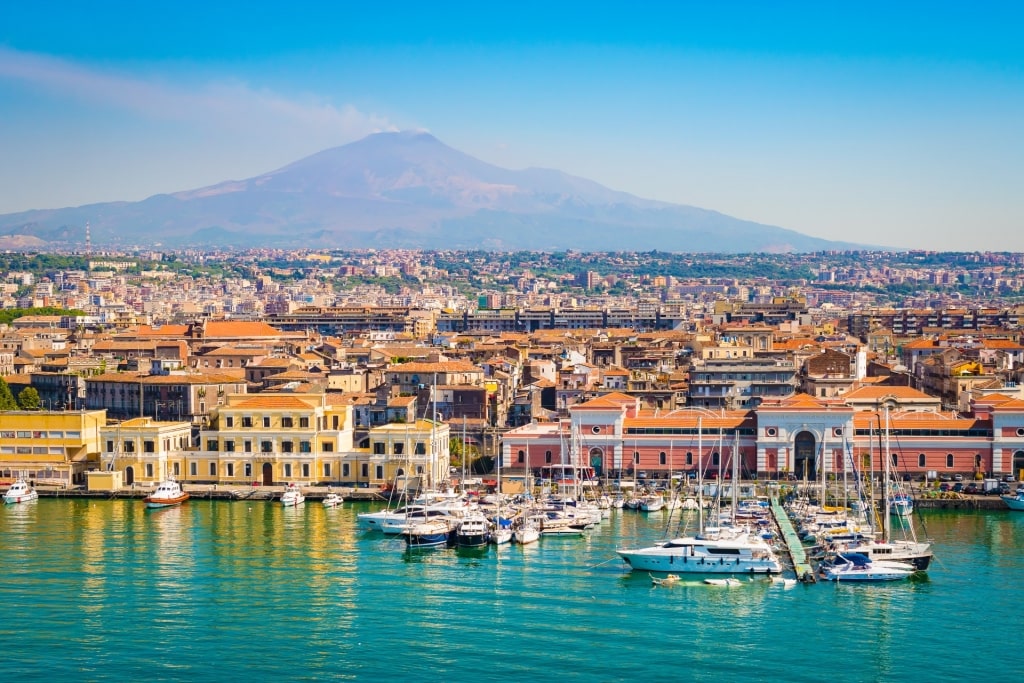
Catania
Its roads paved with basalt and with Mount Etna looming on the horizon, Catania, Sicily’s southerly second city, has long had an intimate and tempestuous relationship with that famous volcano.
Catania’s history and architecture have been shaped by seismic disturbance. When an earthquake in the 17th century demolished much of the city, it was remade in a handsome baroque style that drew similarities with Milan.
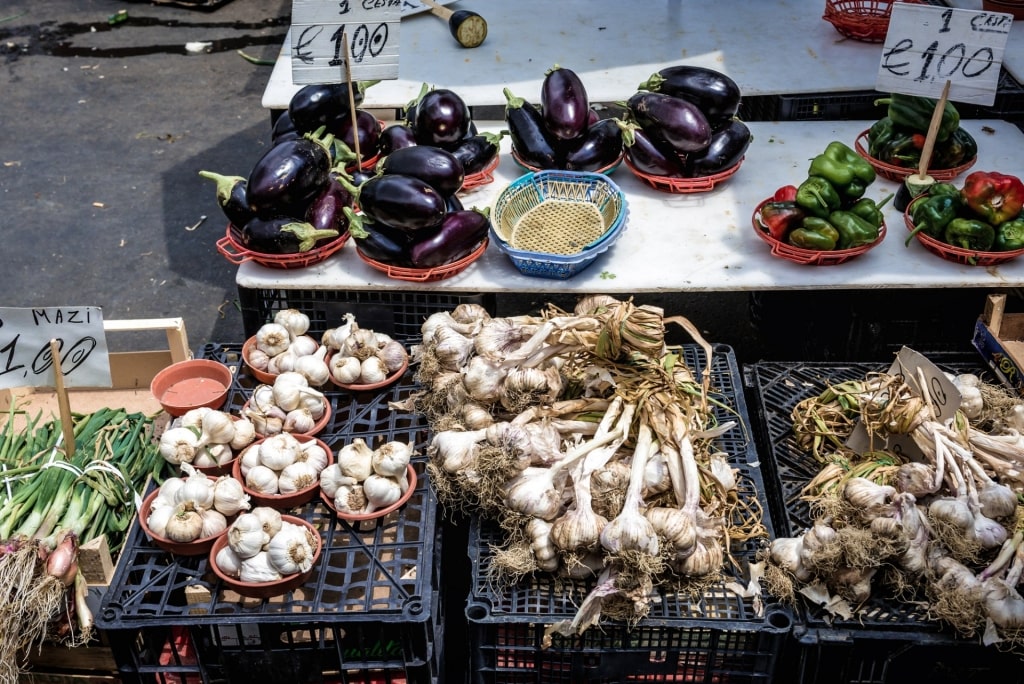
Mercato di Piazza Carlo Alberto, Catania
However, unlike that fashion-fanatical northern Italian city, Catania’s compact center thrums with Sicily’s complex, compelling culture. This is at its most concentrated beneath the carpet of umbrellas shading Catania’s Mercato di Piazza Carlo Alberto, the main flea and grocery market.
Wander through this scene of operatically Sicilian commerce, possibly picking up a pair of counterfeit D&G sunglasses for a souvenir. Afterward, find your way to one of the city’s many quieter piazze for a cappuccino or cup of granita.
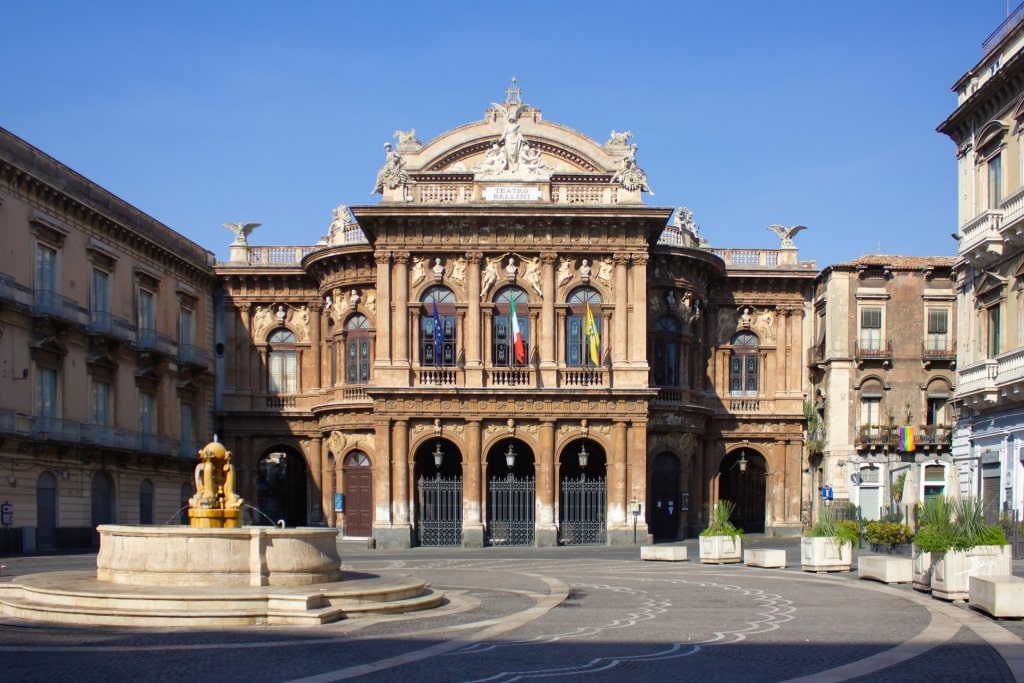
Teatro Massimo Bellini, Catania
Without the overwhelming local color, you’ll begin to see Catania’s casual loveliness and take in its architectural treasures, such as its flamboyant Teatro Massimo Bellini opera house. Wander on through the historic center, passing pasta boutiques and bars leaking football match commentary, and you’ll eventually arrive at Castello Ursino.
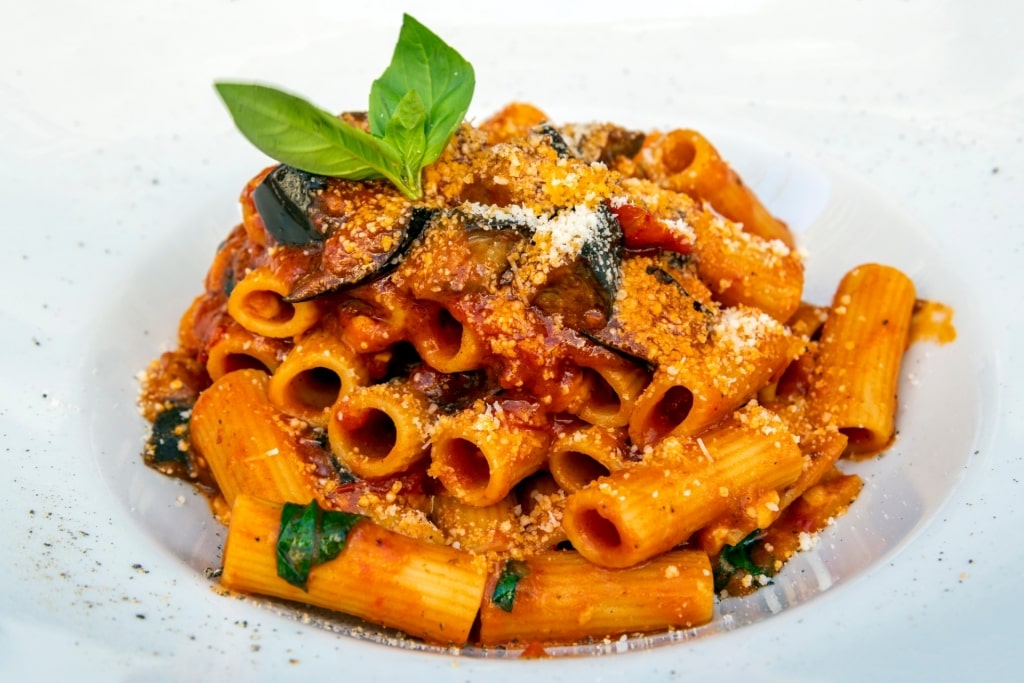
Pasta alla norma
Within its stout 13th-century walls, you’ll find a museum with a wide-ranging remit that also covers the city’s traumatized history. After consuming your fill of history, find Ristorante da Antonio for a bowlful of pasta alla norma, one of Catania’s most iconic dishes.
Read: Best Dishes in Italy
Messina
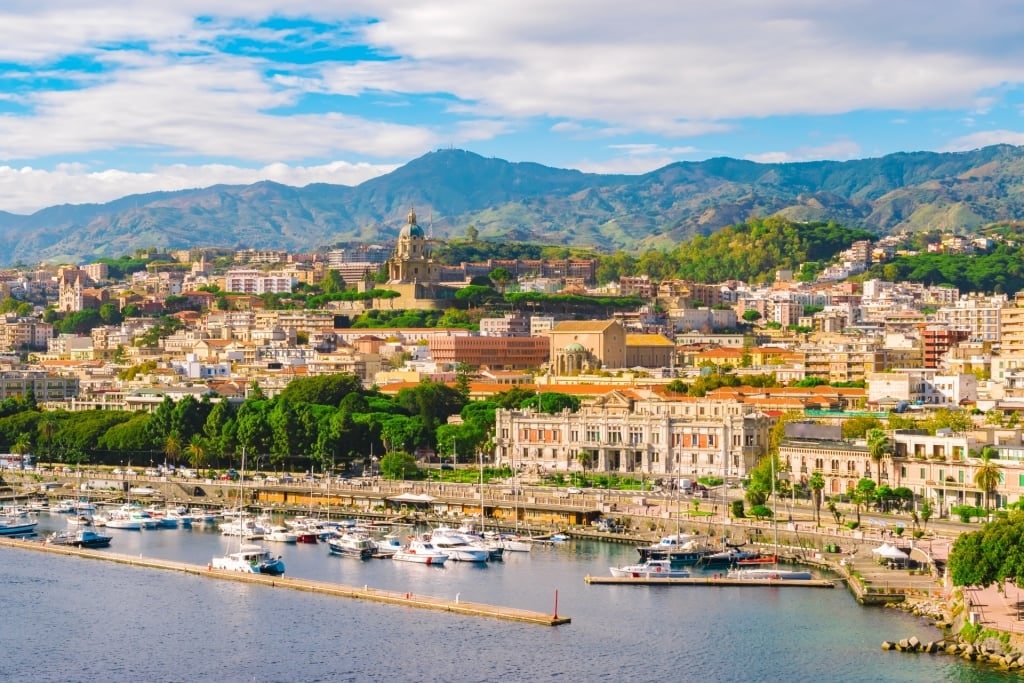
Messina
Sicily’s third-largest city, Messina is probably most well known as the crossing point for travelers from the Italian mainland—those August hordes seeking the island’s soft sand beaches, characterful hill towns, and exuberant festivals.
Approaching Capo Peloro by boat (or on one of the continent’s last remaining train ferries), these visitors cruise into the Mediterranean’s largest natural harbor. Arrayed behind its azure expanse is stately Messina. Backed by the coastal mountains, the city is a haze of sloping terracotta rooftops with domes rising from its historic center.
Despite several seismic facelifts, Messina remains one of the most beautiful cities in Italy. In the main, this is thanks to the loving diligence shown in the restoration and preservation of its architectural and cultural treasures.
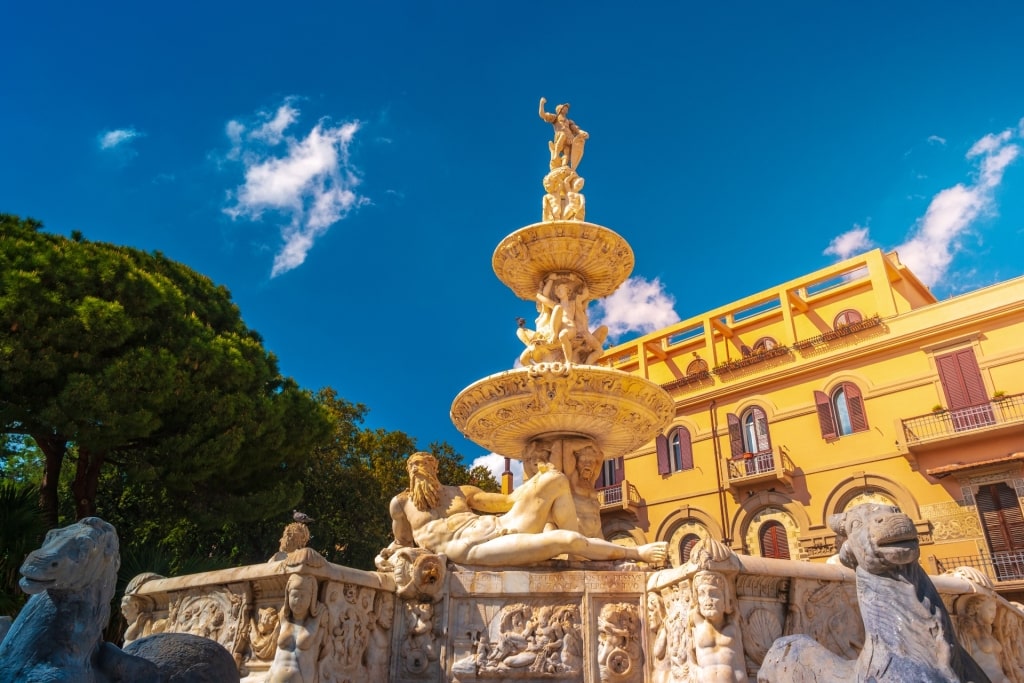
Fontane di Orione, Messina
Among these are the gorgeous Renaissance-era Fontane di Orione fountain; the city’s profoundly beautiful monumental cemetery; and the world’s most complex mechanical and astronomical clock found in Piazza Duomo.
It’s also a city of statues. As you wander the streets, you’ll see these carved idols peeping out from niches and on side streets, representative of wealthy former citizens or heroes of the city.
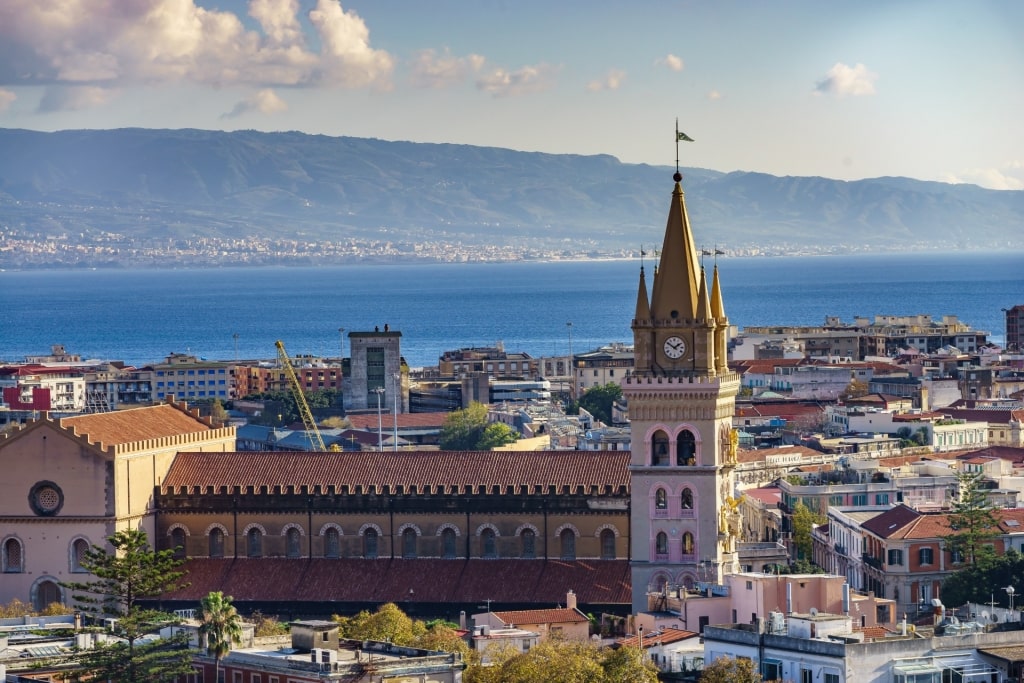
Messina
They’re a reminder of the stories that swirl around this ancient port city, whether Homerian in origin or Christian. St. Paul the Apostle is believed to have arrived by ship at Messina to convert Sicily to Christianity. But this isn’t just a city of myth, legend, and petrified likenesses. It’s a vibrant place, especially along the waterfront.
It’s also one of the best places from which to take a trip to the volcanic Aeolian Islands (if only to return to see Messina rising above the water once more).
Portofino
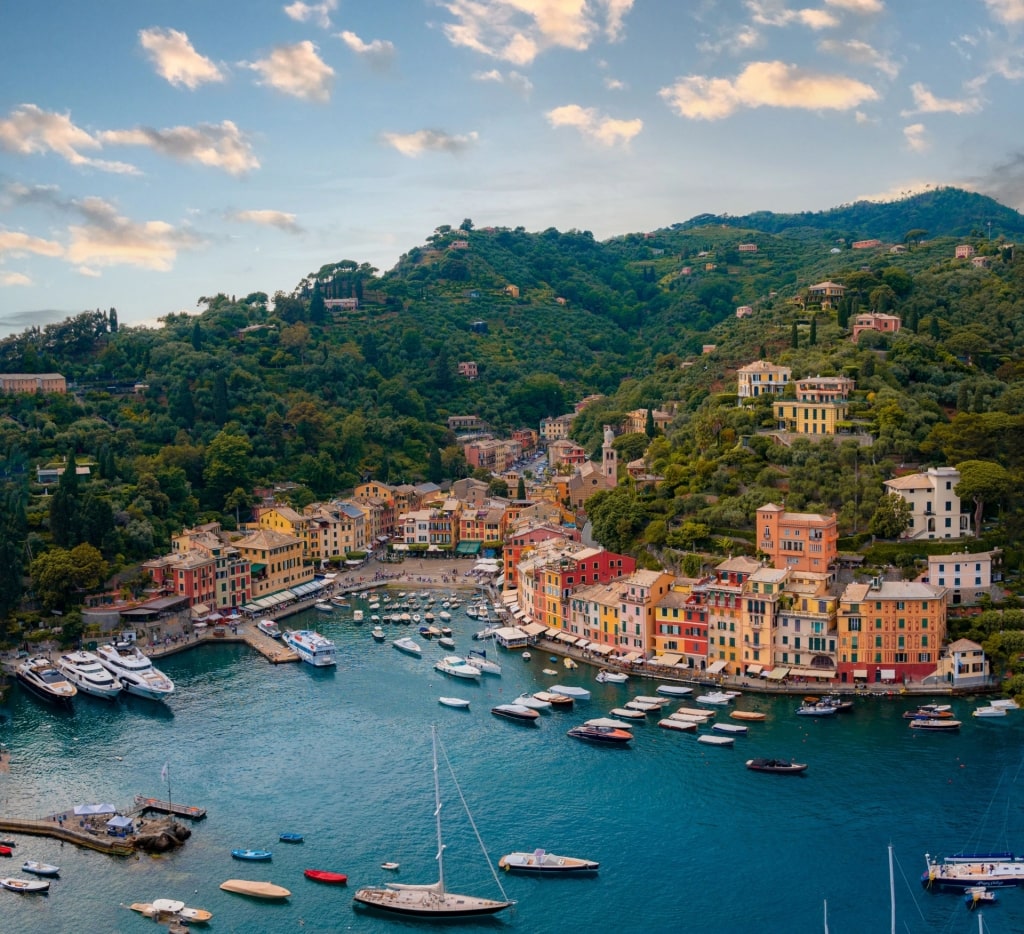
Portofino
It may be difficult to categorize Portofino as one of the most beautiful cities in Italy due to its fishing village footprint; there are only 400 full-time inhabitants. However, it’s undeniable that Portofino has an outsized reputation more suited to a metropolis than a pastel-hued Ligurian town.
And the argument for its inclusion goes further when considering the extent of its nominal borders. The verdant peninsula that Portofino sits on bears its name, while the approaching superyachts cast a whale-sized shadow across the swaying seagrass meadows of Portofino Marine Park.
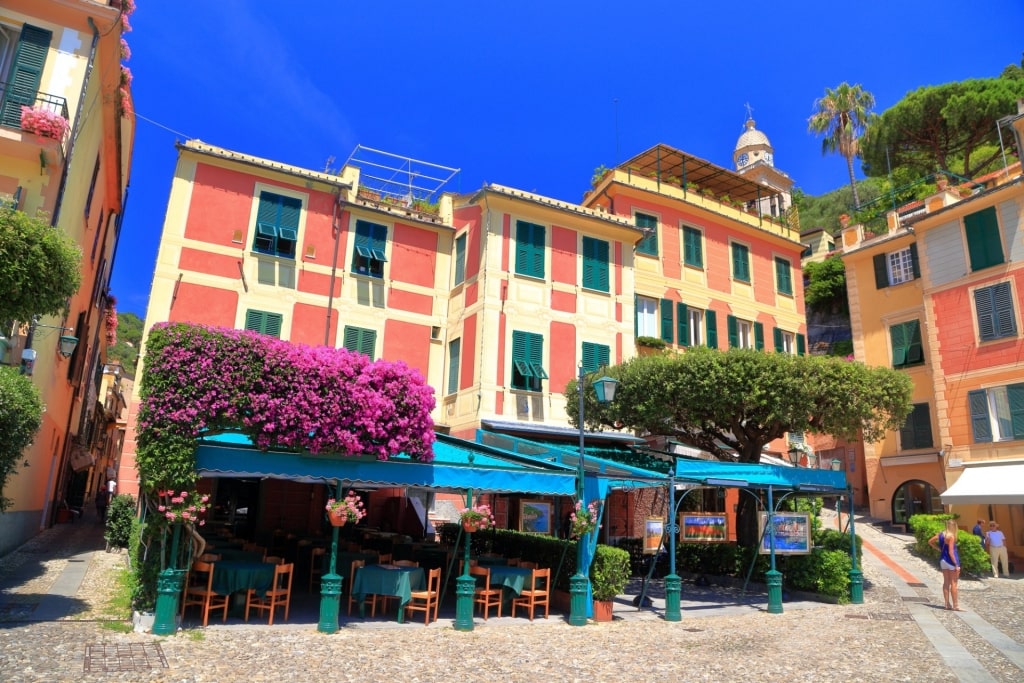
Portofino
And in high season, the population of this village swells to something approaching a small city. These travelers arrive in numbers to seek to taste that allure that led to Portofino becoming a jet-set enclave in the 1960s.
Resilient to change, this Italian coastal town remains much as it was then: a rainbow refraction of Ligurian architecture cast against lush, craggy cliffs. Along the water’s edge, naval flags flutter in the warm breeze.
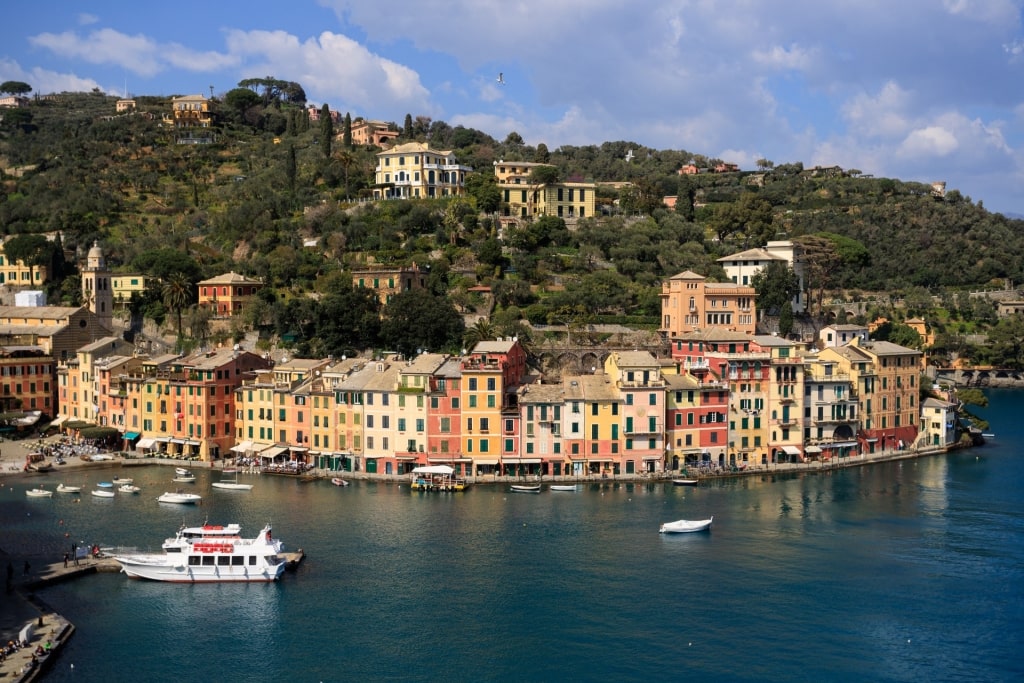
Portofino
You can’t arrive by car (yet another reason why Portofino is hamstrung in its urban ambitions). Of course, an absence of Fiats and scooters crammed in like a particularly untidy game of dominoes means that the Piazzetta’s cobbles are freed up for the curious pedestrian.
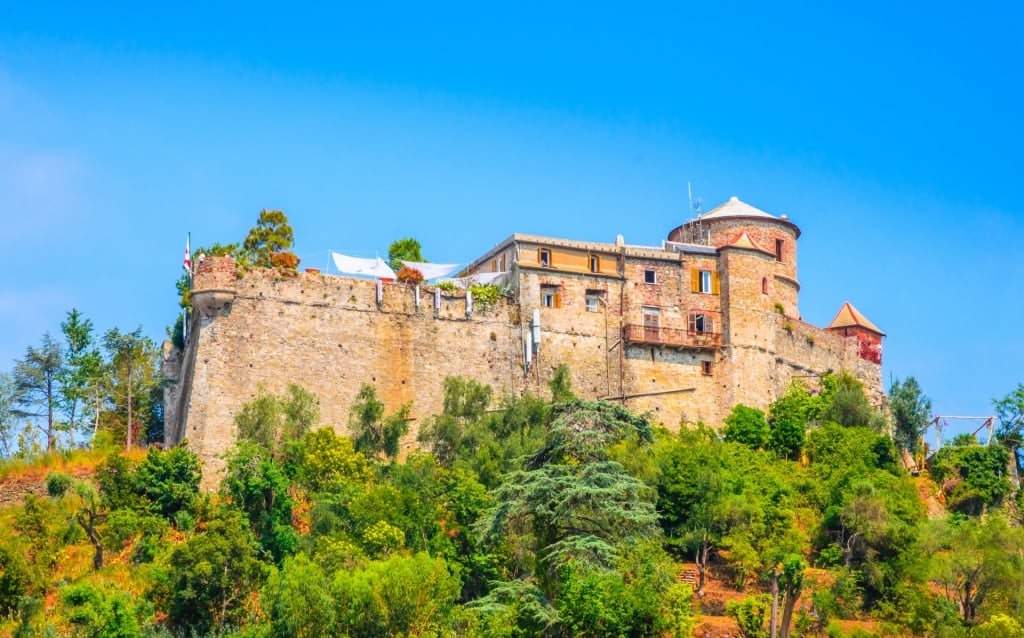
Castello Brown, Portofino
While arriving by boat is the most popular option (the photographic angle is perfetto), there is a straightforward hour-long walk that starts at Santa Margherita and winds through the gorgeous Portofino Regional Park. One of the best things to do in Portofino include visiting the charming San Giorgio church, or Castello Brown, a historic house museum with stunning views.
Livorno
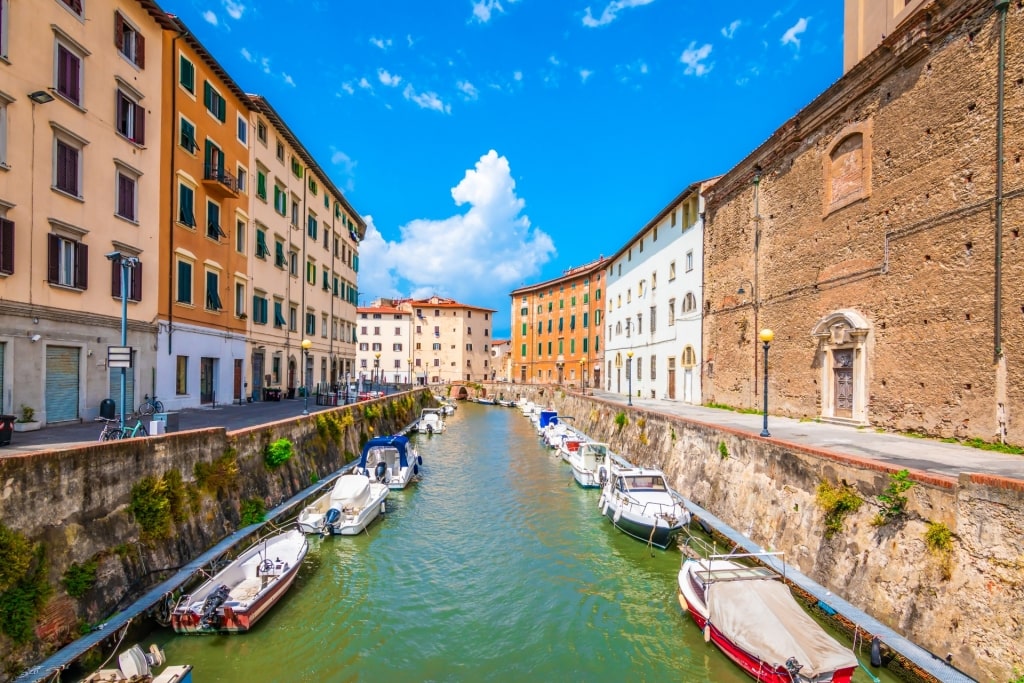
Livorno
If you arrive in Livorno by boat, the sight of Fortezza Vecchia, its weathered brick walls slipping beneath the harbor waters, delivers an instant dose of medieval Mediterranean history.
Tuscany’s third largest city and a major port, the medieval fortress stands guard as it did when the 19th-century Grand Tourists arrived with their trunks, manservants, and thirst for Renaissance illumination.
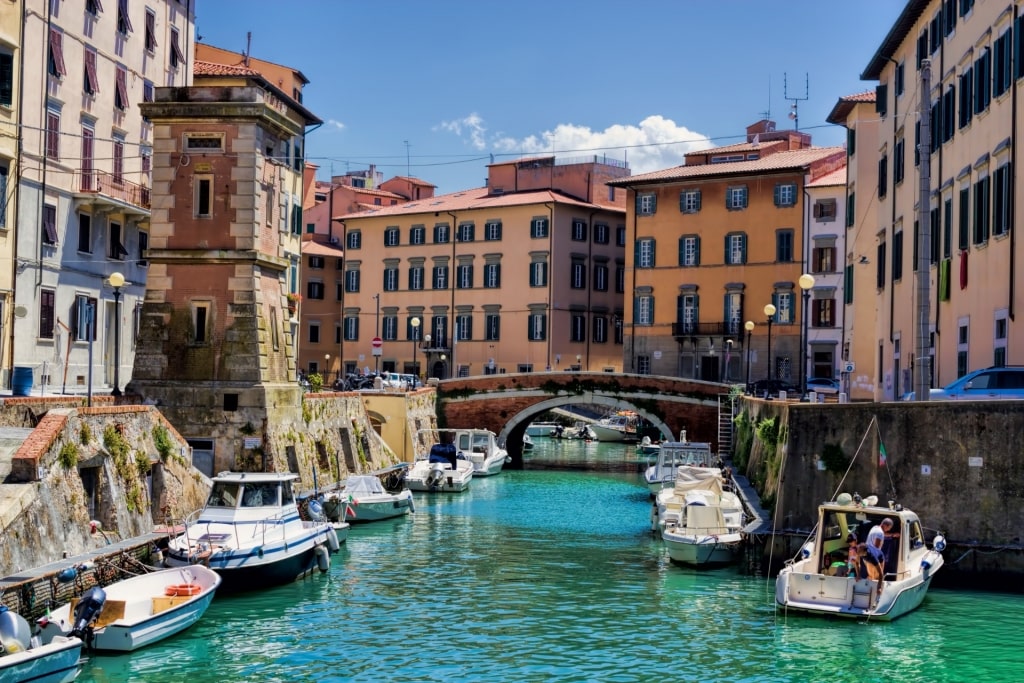
Livorno
Often, Livorno is seen as only a gateway to Tuscany’s more high-profile hinterland, the location of cities such as Florence and Siena. However, the Grand Tourists knew better. Take your cue from them and linger in this, one of the most beautiful cities in Italy, soaking up its sights and sounds, as well as the authentic Tuscan culture.
The pearl in this briny oyster of a port is its 17th-century canal district, Venezia Nuova (authenticity endowed by the Venetian building talent that constructed it). Lined with pastel-painted merchant houses, the canal jinks away from the busy port and into this district’s serene surroundings.
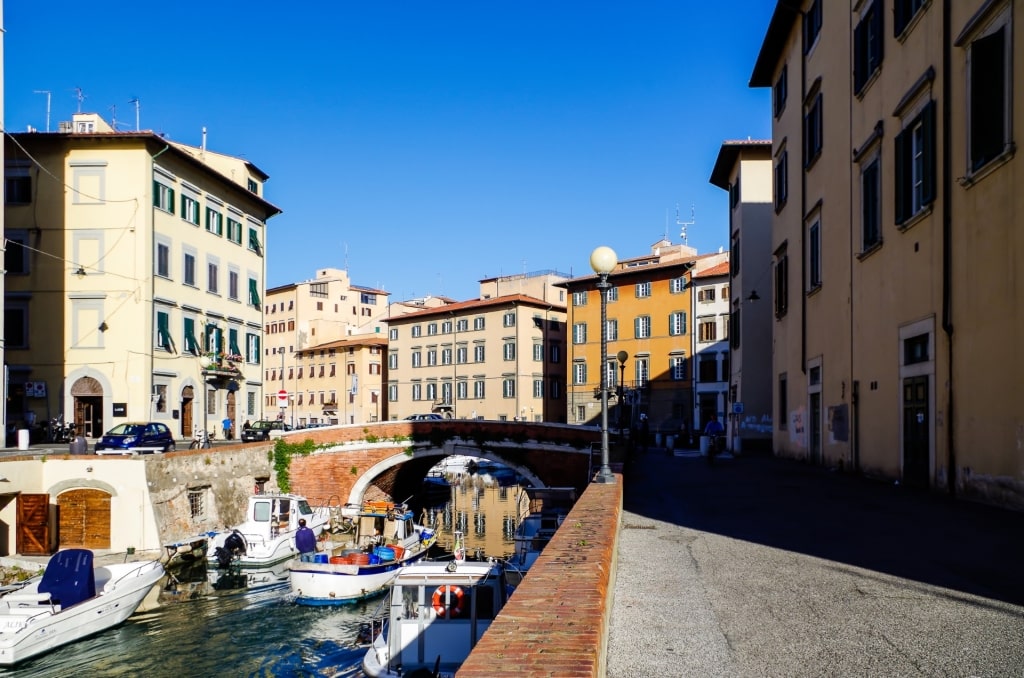
Venezia Nuova, Livorno
Venezia Nuova is particularly enchanting at night, the bridges underlit in deep blue while the street lanterns glow softly. Aperitivo hour is lively here, especially at popular La Ponceria, with Aperol spritz and boards of antipasti enjoyed in bars that inhabit the spaces that once stored the stock of medieval merchants.
Beyond the canals, there are other districts to discover such as up-and-coming San Jacopo. Walk the promenade for sea views, gelato strolls, and gin palace-spotting. And whatever you do, don’t leave Livorno without having tried its traditional cacciucco fish stew at a family-run trattoria such as Il Sottomarino.
Ravenna
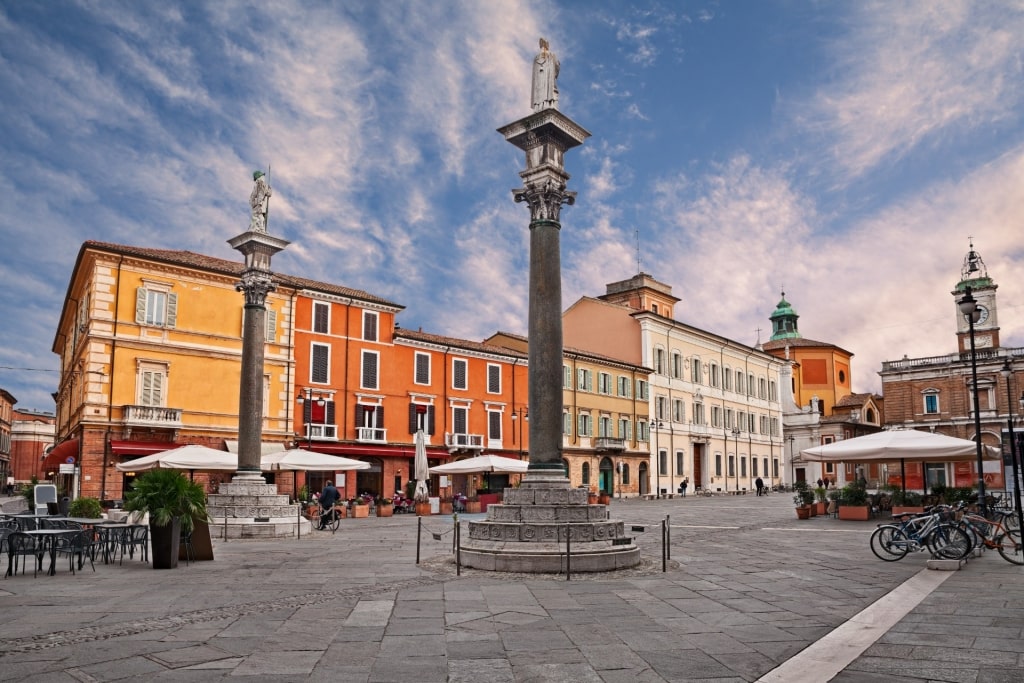
Ravenna
For many visiting the Italian region of Emilia-Romagna, it’s easy to be pulled in by Bologna’s medieval and culinary gravity. The regional capital is well worth a long, gluttonous weekend.
But nearby Ravenna, once the capital of the Western Roman Empire, is a too-often overlooked gem in Italy (and its menus still offer tortellini in brodo, or tortellini in broth, a Bologna specialty).
As Ravenna rubs shoulders with the Adriatic, you’re sure to find more seafood on the menu as well. The calories are easily worked off while you explore this small city’s wealth of UNESCO World Heritage Sites, such as the magnificent Mausoleum of Galla Placidia.
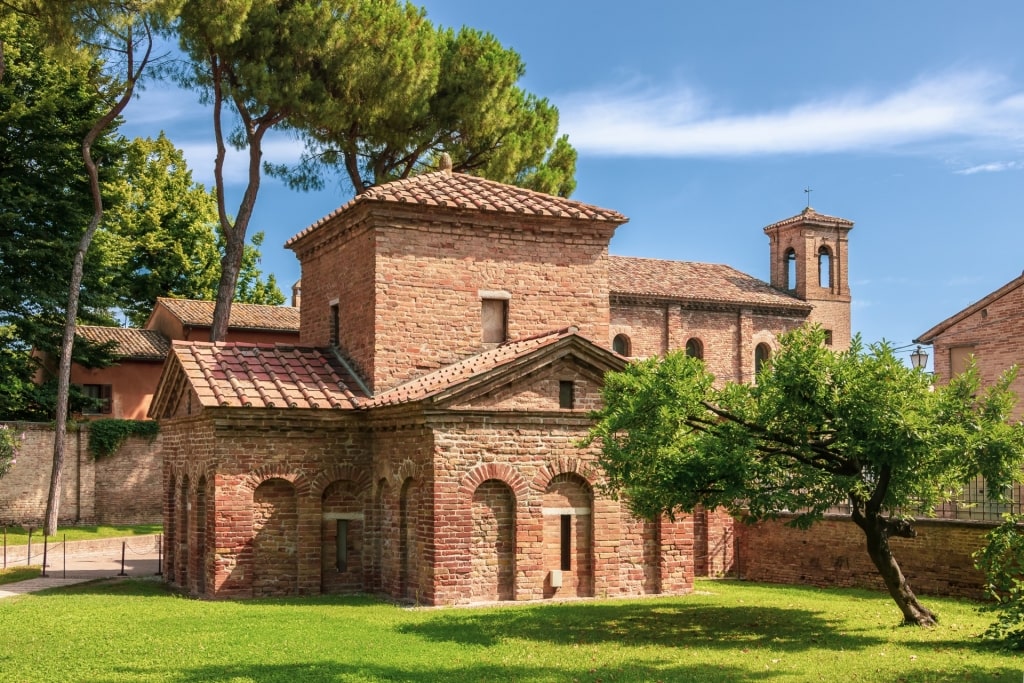
Mausoleum of Galla Placidia, Ravenna
Visiting this beautifully preserved Roman structure is one of the best things to do in Ravenna, as you’ll be swept up in the breathtaking blue mosaic that patterns its ceiling.
Another unmissable example of Ravenna’s inner luminosity is the Basilica of San Vitale. Viewed by many as one of Italy’s most shining examples of Byzantine architecture, its interior decoration is a dazzling mosaic and fresco synthesis of East and West.
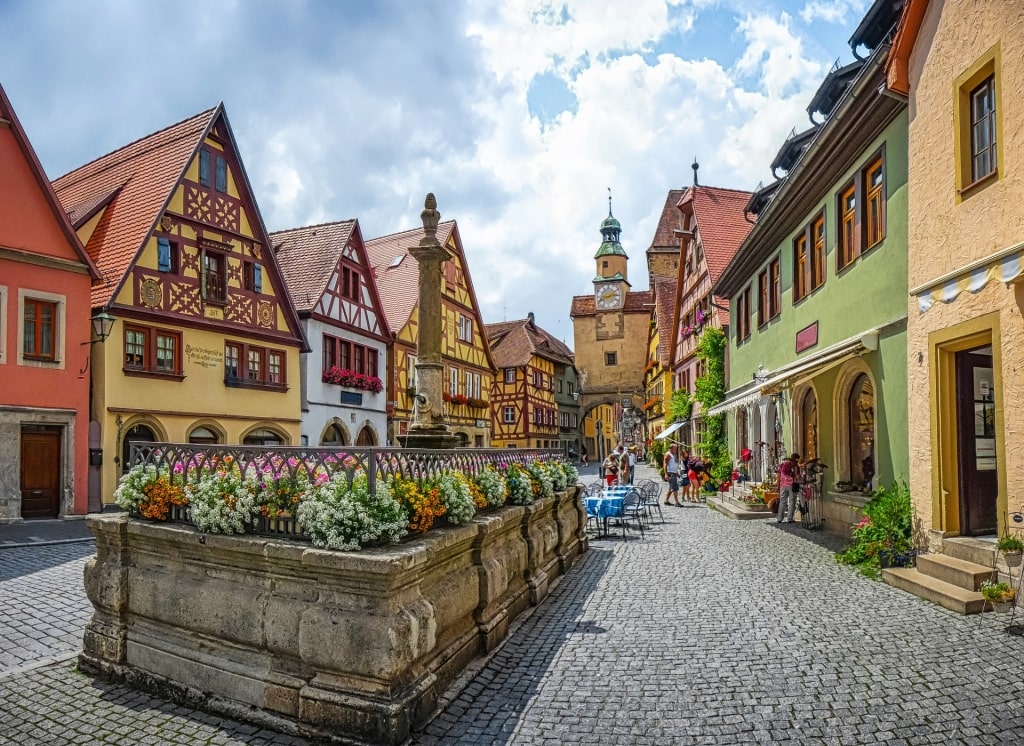
Piazza del Popolo, Ravenna
However, not all of the treasures in Ravenna, one of the most beautiful cities in Italy, are indoors. Piazza del Popolo is a wonderfully haughty square, having been the center of power since the 13th century. Medieval Venetian elements speak to the influence that the nearby La Serenissima wielded over Ravenna.
In the piazza, impressive things to experience (in no particular order) include the 14th-century Palazzo del Podestà, the neoclassical Ravenna Cathedral, and the prosciutto piadina with crumbly squacquerone cheese from takeaway La Tonda.
Bologna
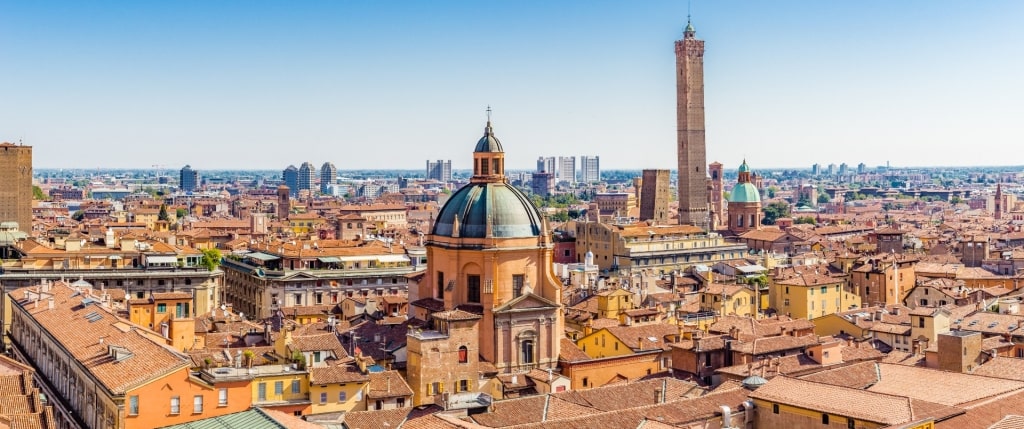
Bologna
Bologna, the capital of Emilia-Romagna, has worldwide name recognition thanks to its rich Bolognese sauce.
Multitudes of foodies from every corner of the globe travel here to devour its tortellini in brodo, try slices of authentic mortadella, and experience its tagliatelle alla bolognese in a traditional trattoria. What they perhaps don’t expect is that Bologna also happens to be one of the most beautiful cities in Italy.
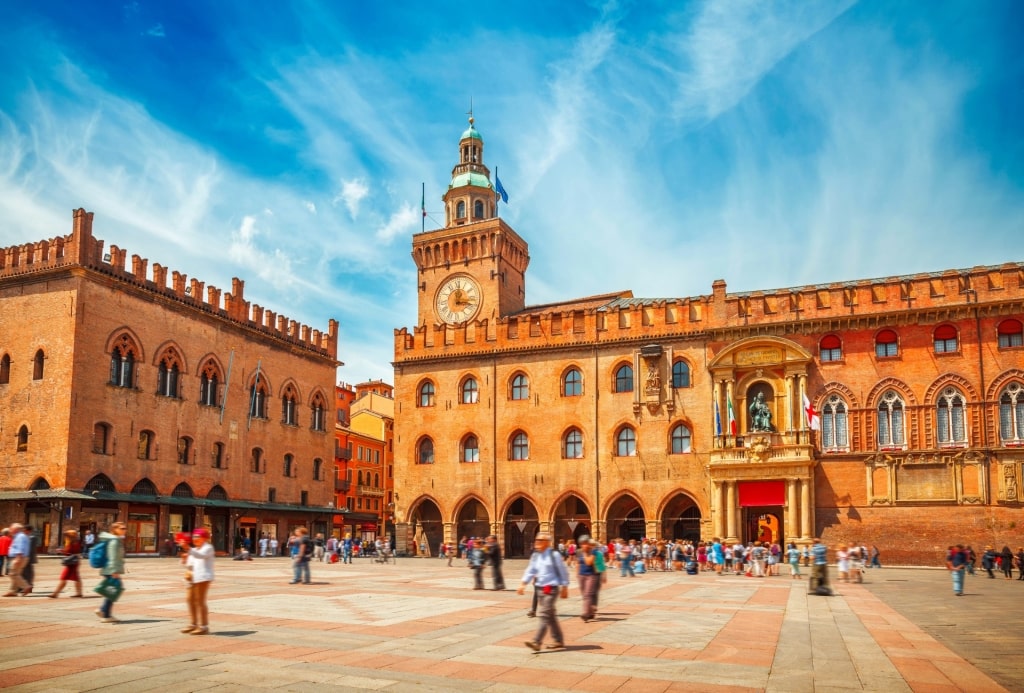
Piazza Maggiore, Bologna
Visitors most likely already recognize its Piazza Maggiore from social media. Visiting this striking central square is one of the best things to do in Bologna as it has remained mostly unchanged since the 15th century. Its warm terracotta hues and weathered porticoes are wonderful to walk among, whether you’re looking for your next snack or trying to find the triumphant Fontana del Nettuno.
Seekers of visual delights should follow the city’s covered sidewalks, which extend to over 30 miles, to reach the Certosa Monumental Cemetery. Wandering amid this unintentional outdoor sculpture garden, look for the grave of Ferrucio Lamborghini (no prizes for guessing his life’s work).
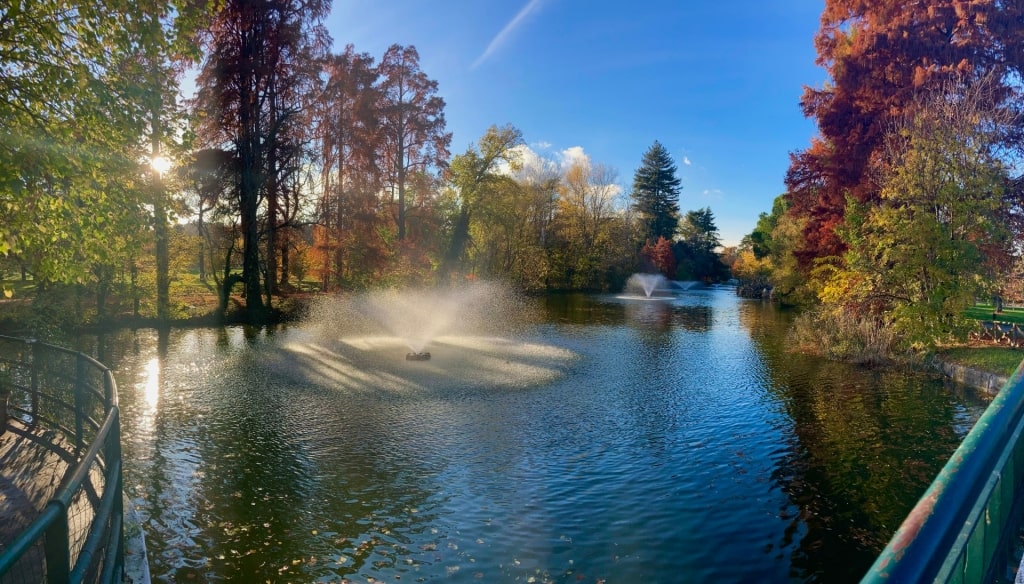
Giardini Margherita, Bologna
The 19th-century Giardini Margherita also contributes to Bologna’s beauty. The city’s largest park is designed in an English Romantic style.
A shady retreat from the city center, you’ll find pop-up Italian markets, an Etruscan burial ground, and a turtle sanctuary. In autumn, the trees put on a stunning display with shades of aubergine, terracotta pink, and, of course, bolognese ragu red.
Experience all of these beautiful cities and more on a cruise to Italy. Browse our cruise itineraries online and book an incredible vacation to Italy.
